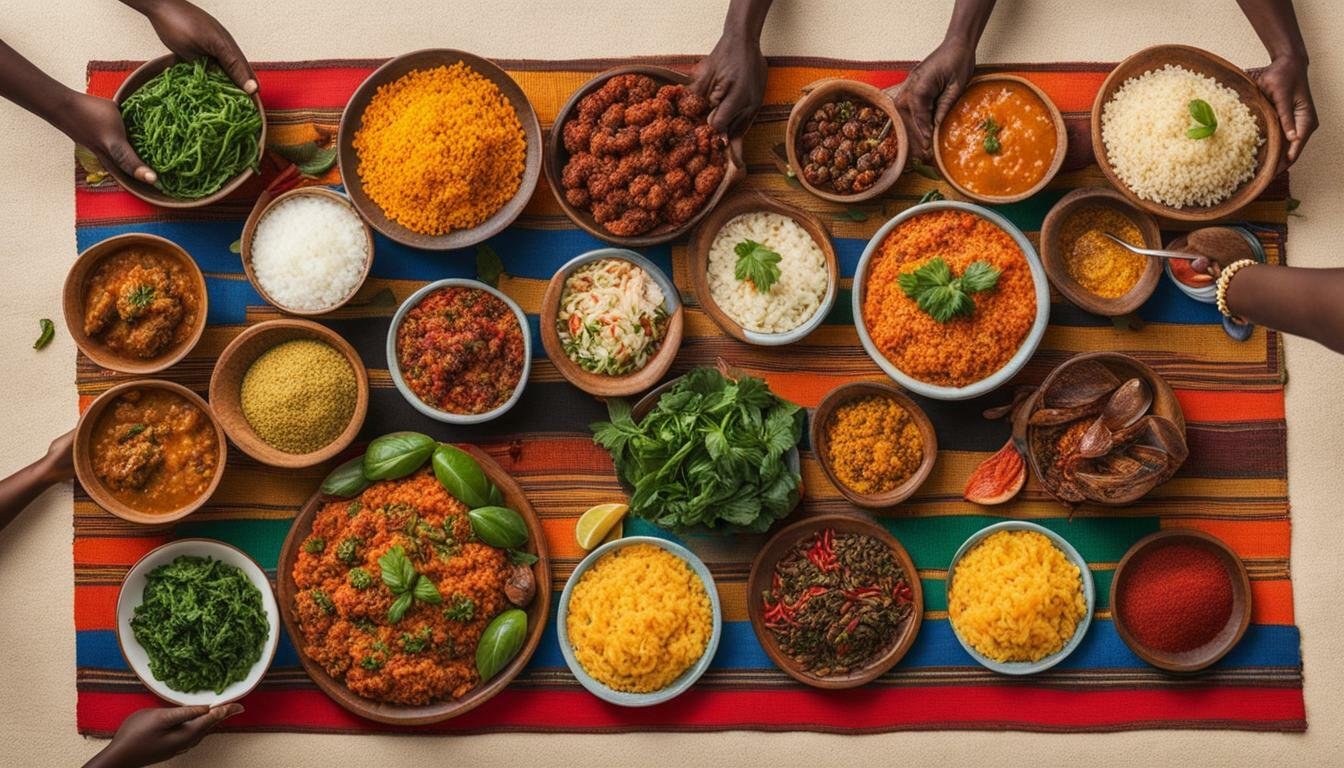Take Me to the Recipes
Imagine yourself strolling through bustling markets bursting with colorful fruits and vegetables, the air thick with the aroma of savory spices. This isn’t just a daydream; it’s a glimpse into the vibrant world of Ghanaian cuisine, waiting to tantalize your taste buds and broaden your culinary horizons.
Ghana, nestled along the West African coast, boasts a rich culinary heritage shaped by its diverse landscapes, resilient people, and fascinating history. Each bite of Ghanaian food is a journey through time and tradition, showcasing the creativity and resourcefulness of its people.
But hold on, haven’t you heard some stereotypes about African food being bland or heavy? We’re here to shatter those myths! Ghanaian cuisine is an explosion of flavors, ranging from fiery stews packed with fresh ginger and chilis to comforting, creamy dishes like fufu. With ingredients sourced from fertile fields and bountiful waters, each dish bursts with freshness and vibrant colors.
Whether you’re a seasoned foodie or just curious to explore new cultures, Ghanaian cuisine has something for everyone. Join us on a delicious adventure as we unveil the secrets of this captivating culinary scene. We’ll share mouthwatering recipes, explore the unique ingredients that make it special, and uncover the stories behind each dish.
So, are you ready to embark on a flavor-filled journey to Ghana? Buckle up, grab your virtual fork, and prepare to be amazed!
Intrigued but want more? Dive into our article to:
- Discover the must-try dishes that will blow your mind.
- Learn about the fascinating history and influences that shaped Ghanaian cuisine.
- Find easy-to-follow recipes to bring the taste of Ghana right into your kitchen.
- And so much more!
Get ready to spice up your life with the irresistible flavors of Ghana!
Take Me to the Recipes
Key Takeaways
- Ghanian cuisine is a rich and diverse food culture that reflects the country’s history and cultural heritage.
- Traditional Ghanian spices and cooking techniques define the essence of Ghanian cuisine and contribute to its unique flavors and textures.
- Staple foods in Ghanian cuisine, such as fufu and jollof rice, are a must-try for anyone looking to experience authentic Ghanian dishes.
- Ghanian cuisine offers a range of options for meat and fish lovers, from grilled tilapia to spicy goat stew.
- Even if you follow a vegetarian or vegan diet, you can still savor the flavors of Ghanian cuisine with delicious plant-based dishes.
Where is Ghana?

Ghana is a West African country on the Gulf of Guinea. Its Neighbours are Côte d’Ivoire, to the west, Burkina Faso, which lies north, and Togo, to the east.

Index to the Contents
- Take Me to the Recipes
- More articles
- Interesting Facts About Ghana
- The History of Ghana and how it has affected the Cuisine
- How the Geography and Climate has Affected Ghanian Cuisine
- The Essence of Ghanian Cuisine
- Ghanian Culinary Traditions and Spices
- Ghanian Cooking Techniques
- Staple Foods in Ghanian Cuisine
- Meat and Fish in Ghanian Cuisine
- Vegetarian and Vegan Options in Ghanian Cuisine
- Popular Ghanian Street Foods
- Traditional Ghanian Desserts
- Ghanian Beverages and Drinks
- Ghanian Cuisine: A Celebration of Diversity
- How Healthy is Ghanian Food?
- Bringing the Taste of Ghana to Your Kitchen
- Conclusion
- FAQ’s
More Articles that may Interest You
- North and South American Cuisine – A Culinary Expedition
- Europe Cuisine: Savor the Continent’s Best Culinary Secrets!
- African Cuisine: Discover the Bold Flavors & Global Charm!
- Asian Cuisine Unlock its Secrets – Taste, Health & Global Influence!
Savor iconic Ghanian Food – Click on each tantalizing picture to open up the Recipe
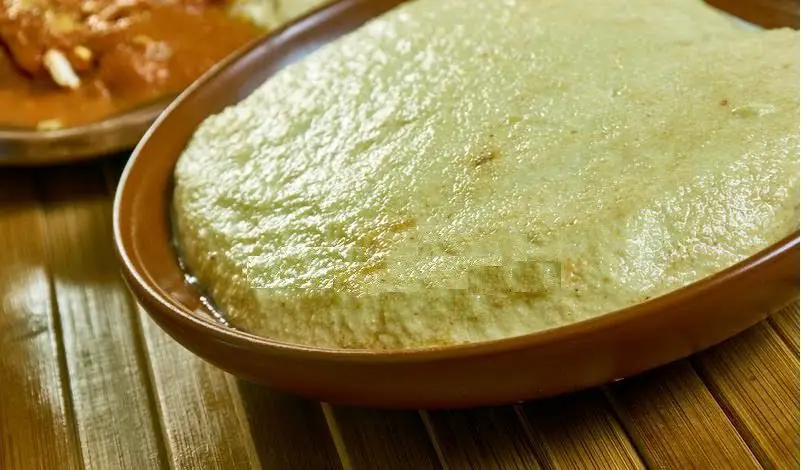


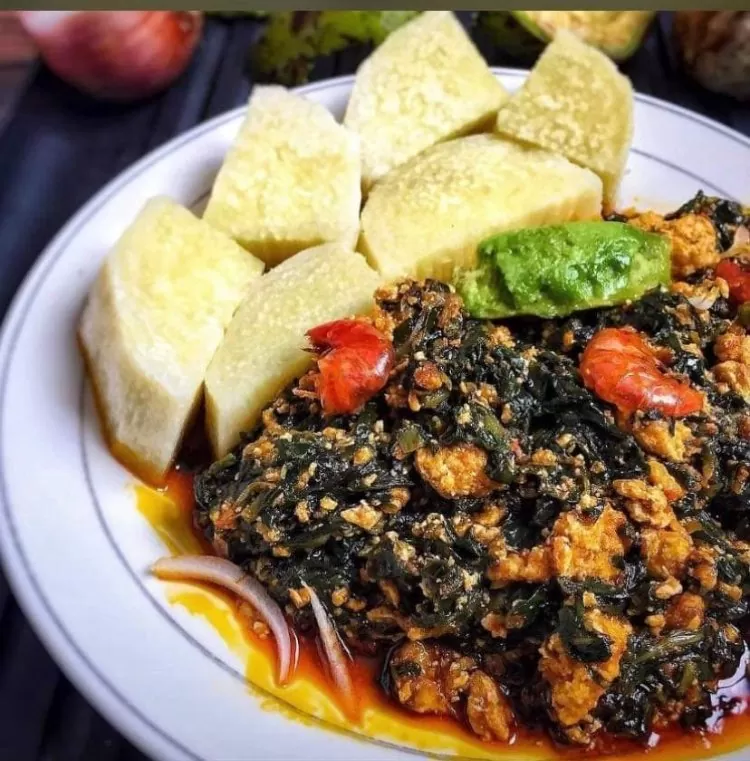
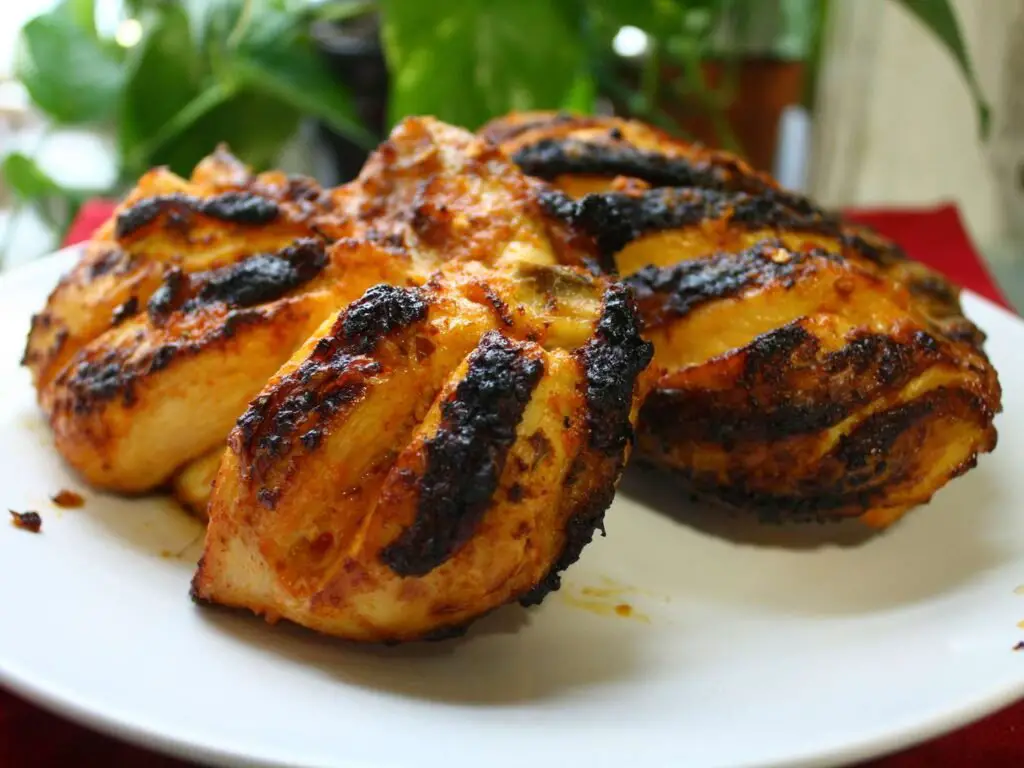
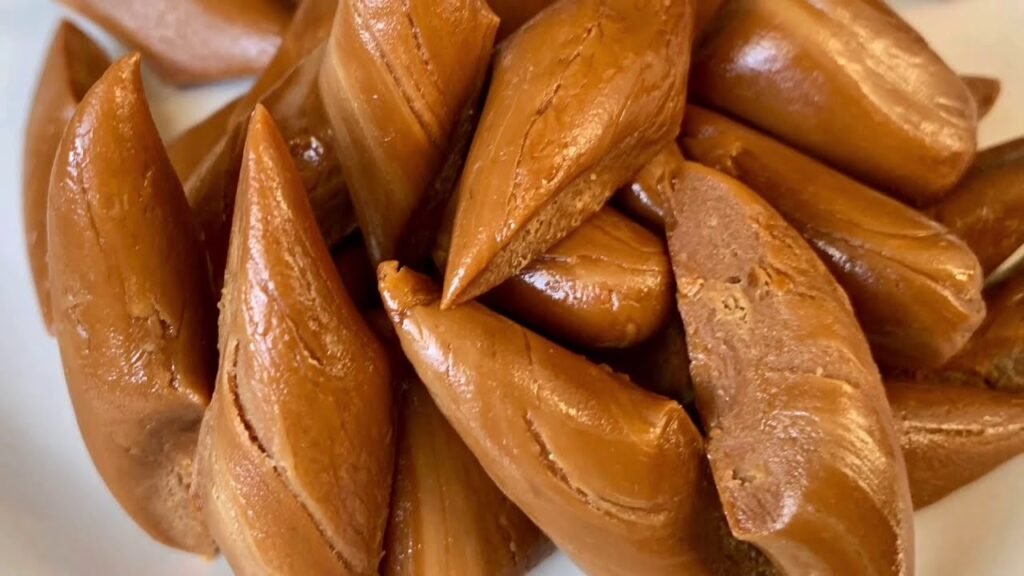
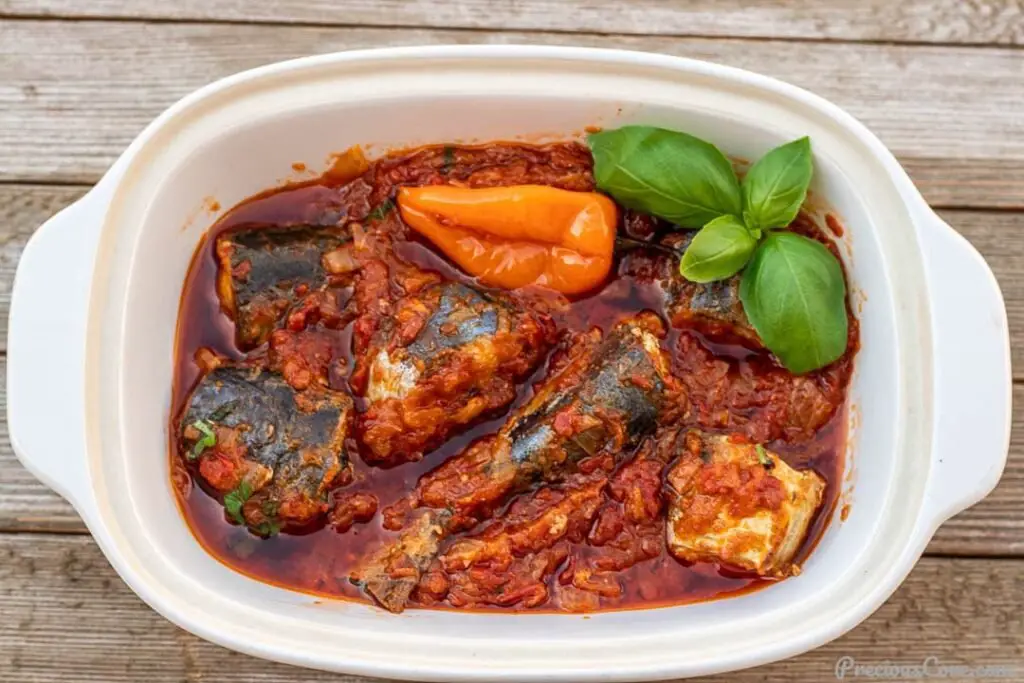
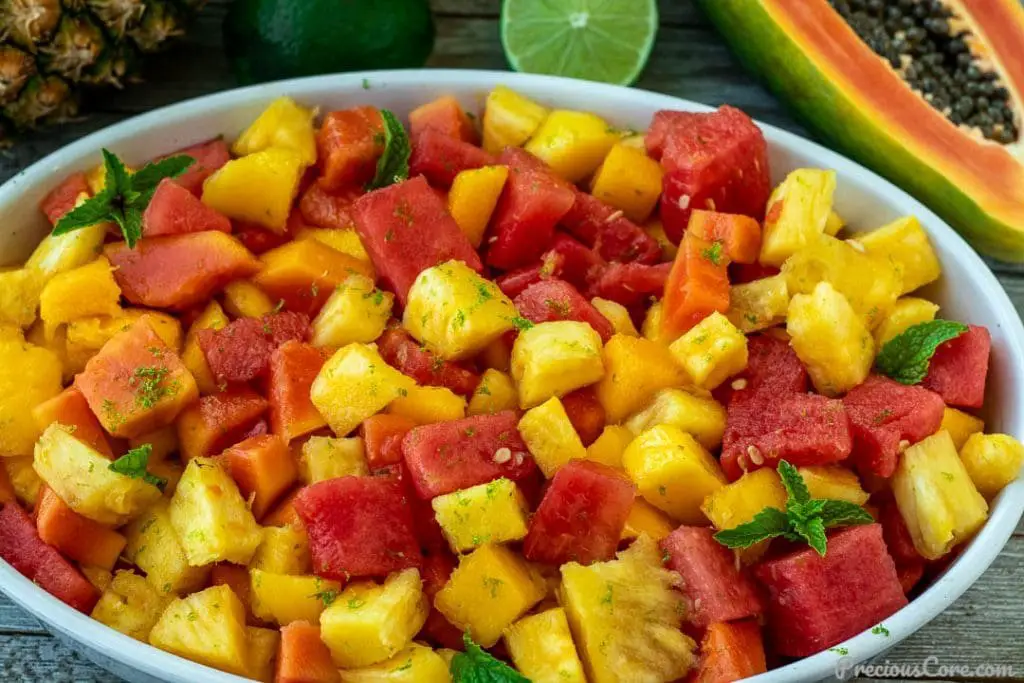

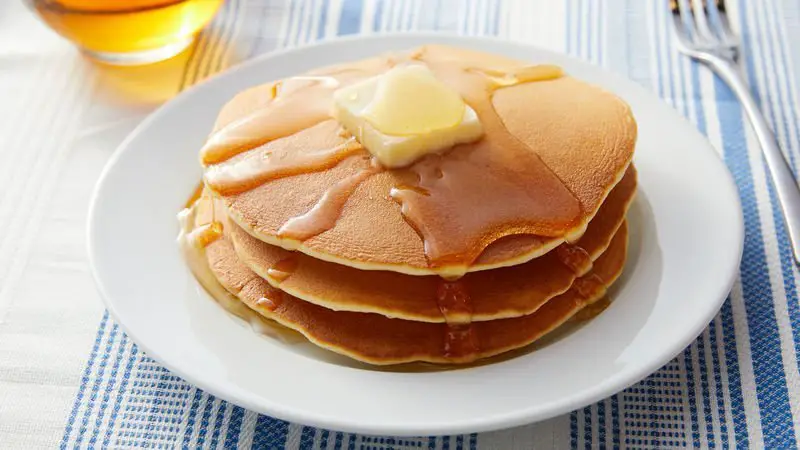

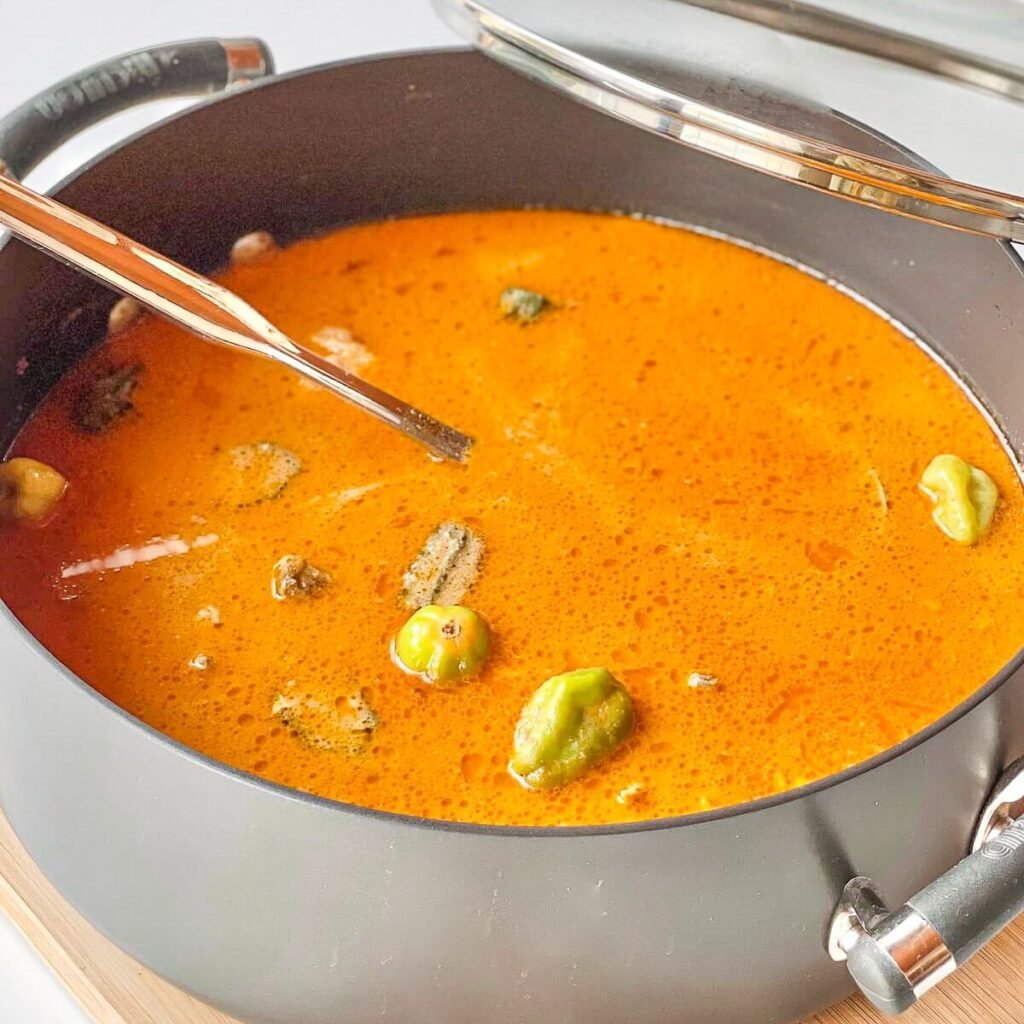




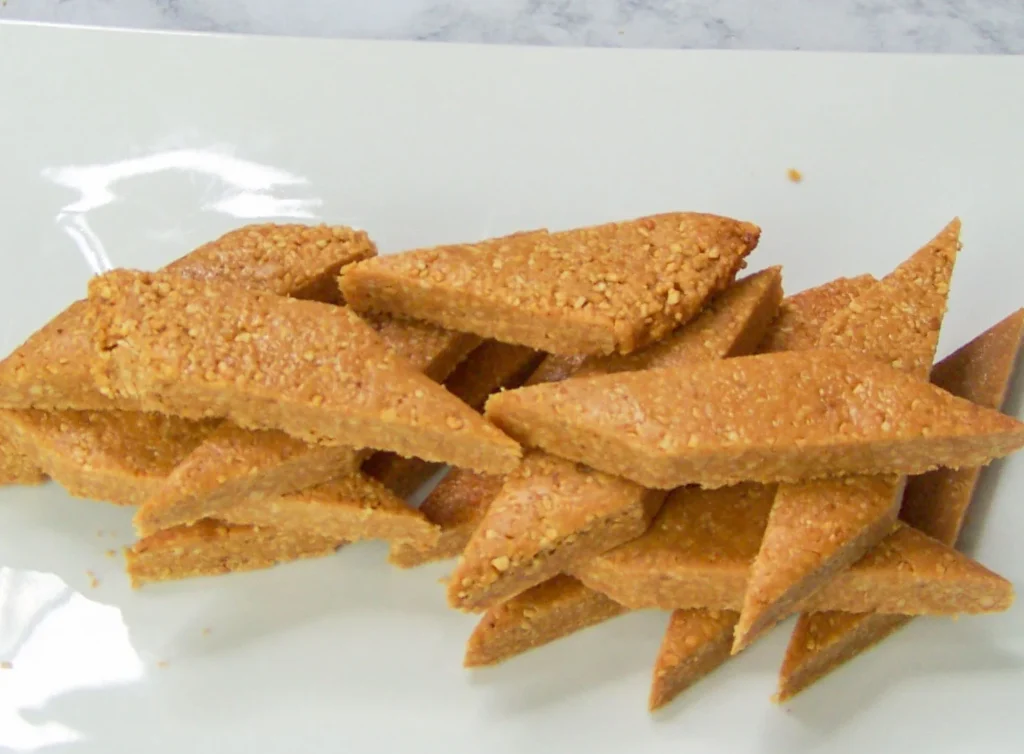

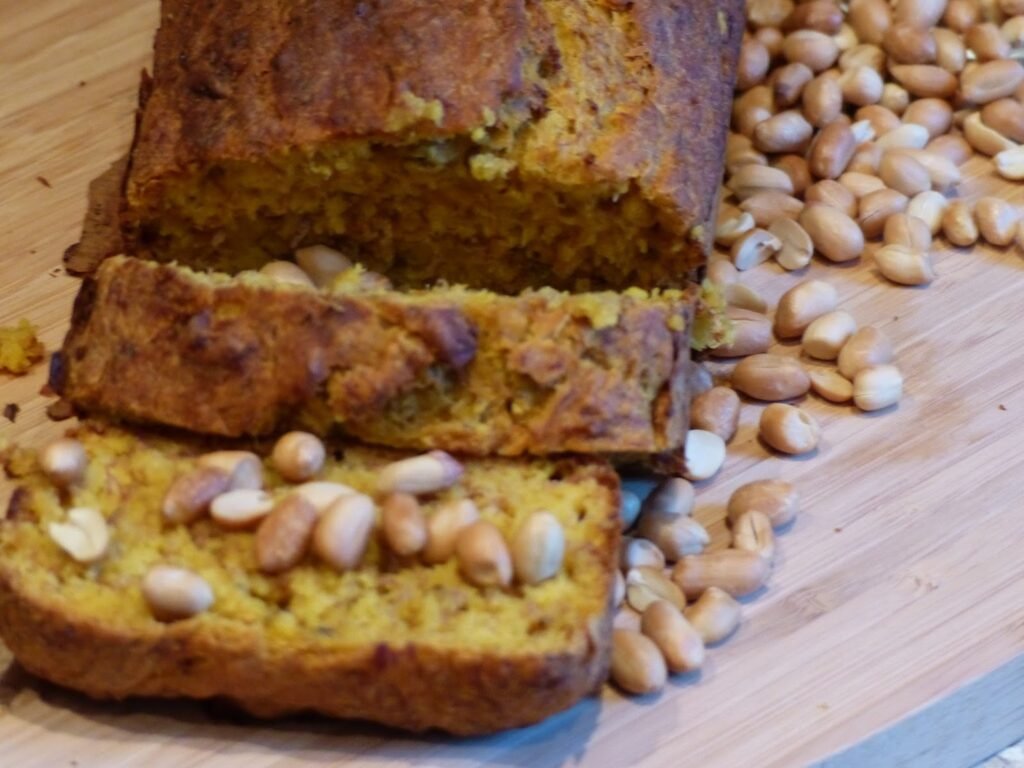
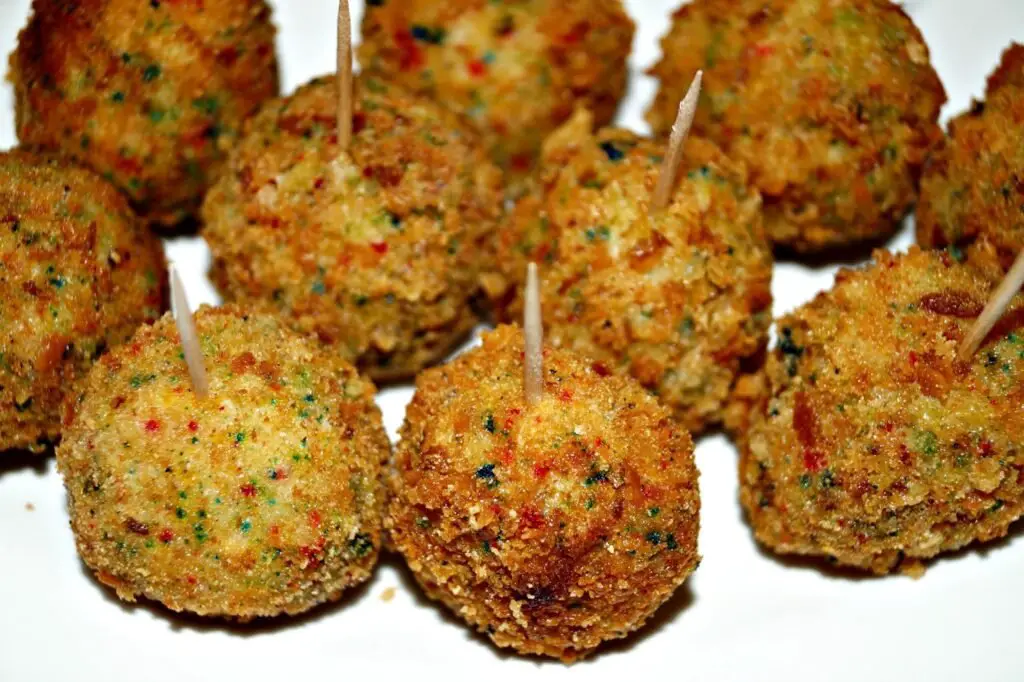
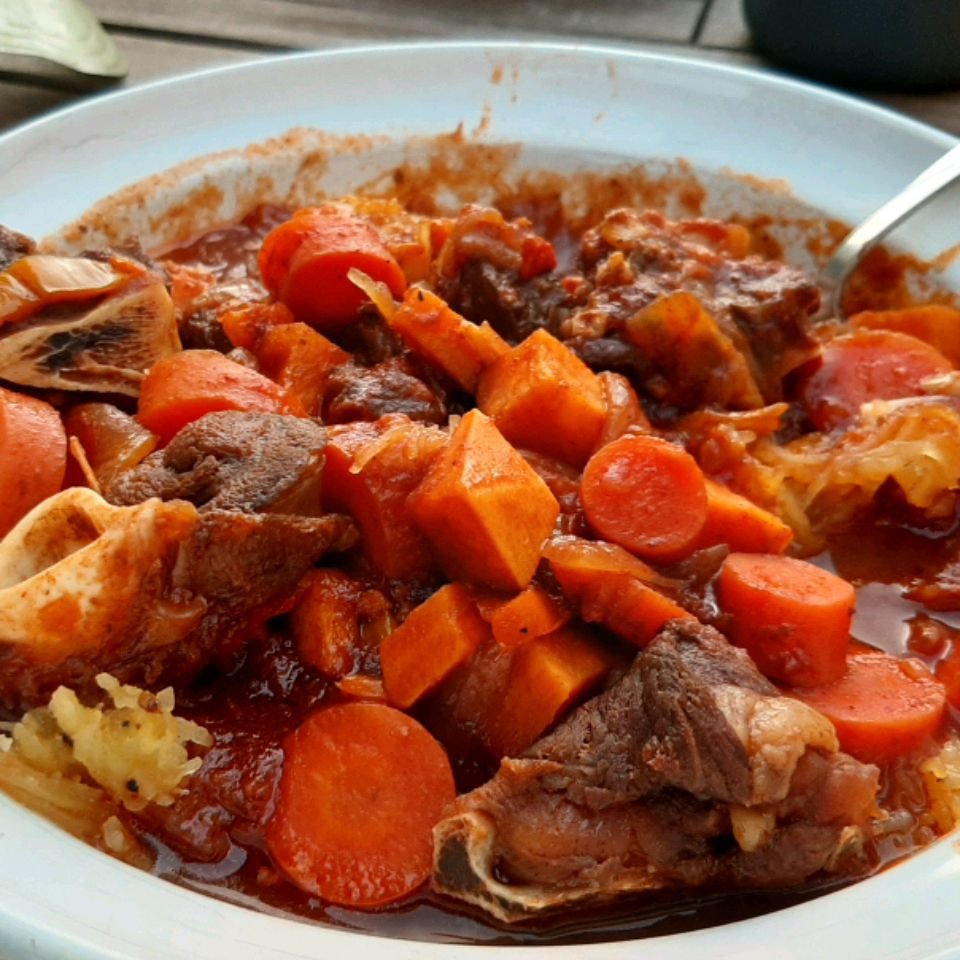

Interesting Facts About Ghana
Chocolate Connection

Ghana is one of the world’s largest producers of cocoa beans, and it’s often referred to as the “Gold Coast of Africa.” Despite this, many Ghanaians have limited access to chocolate due to economic reasons.
Naming Tradition
Ghanaians have unique naming traditions. Children are often named based on the day of the week they were born, with each day associated with specific names.
For example, a boy born on Monday might be named Kojo or Kwadwo, while a girl might be named Adjoa or Adwoa.
Mud and Stick Architecture

The Larabanga Mosque in Ghana is believed to be one of the oldest mosques in West Africa. Constructed with mud and sticks, it’s an excellent example of traditional Islamic architecture.
Kente Cloth
Kente is a brightly colored, handwoven fabric native to Ghana. Each pattern and color in Kente has a specific meaning, often representing historical events, proverbs, or social status.
Witches’ Camps

Ghana has “witches’ camps,” where elderly women accused of witchcraft seek refuge. These camps aim to protect them from potential harm, but the existence of such camps raises human rights concerns.
Giant Snail Delicacy
A popular delicacy in Ghana is the Achatina Achatina, a giant land snail. It is often cooked in various dishes, and its consumption is considered a traditional delicacy.
Independence Arch

Ghana gained independence from British colonial rule on March 6, 1957. The Independence Arch in Accra symbolizes this historic event and is a prominent national monument.
Lake Volta
Lake Volta, one of the largest artificial lakes globally, was created by the Akosombo Dam. While it provides hydroelectric power, the dam’s construction led to the displacement of numerous communities.
National Symbolism
The Black Star Square in Accra is named after Ghana’s national symbol, the Black Star, which represents African freedom. The Black Star was adopted from the flag of Marcus Garvey’s Universal Negro Improvement Association (UNIA).
Ghana’s Sankofa Bird
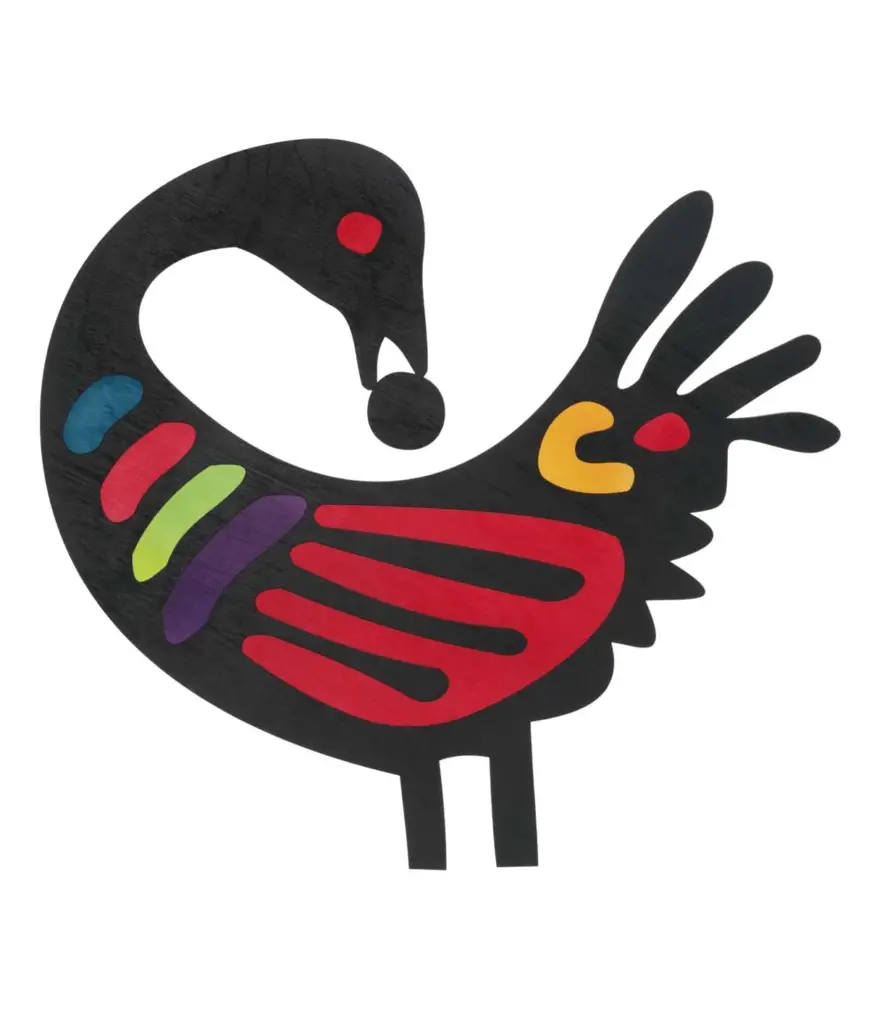
The Sankofa bird, a symbol of the Akan people, is often depicted as a bird with its head turned backward while its feet face forward.
It represents the importance of learning from the past to build a successful future, embodying the Akan proverb “Se wo were fi na wosankofa a yenkyi,” meaning “It is not wrong to go back for that which you have forgotten.”
The History of Ghana and how it has affected the Cuisine
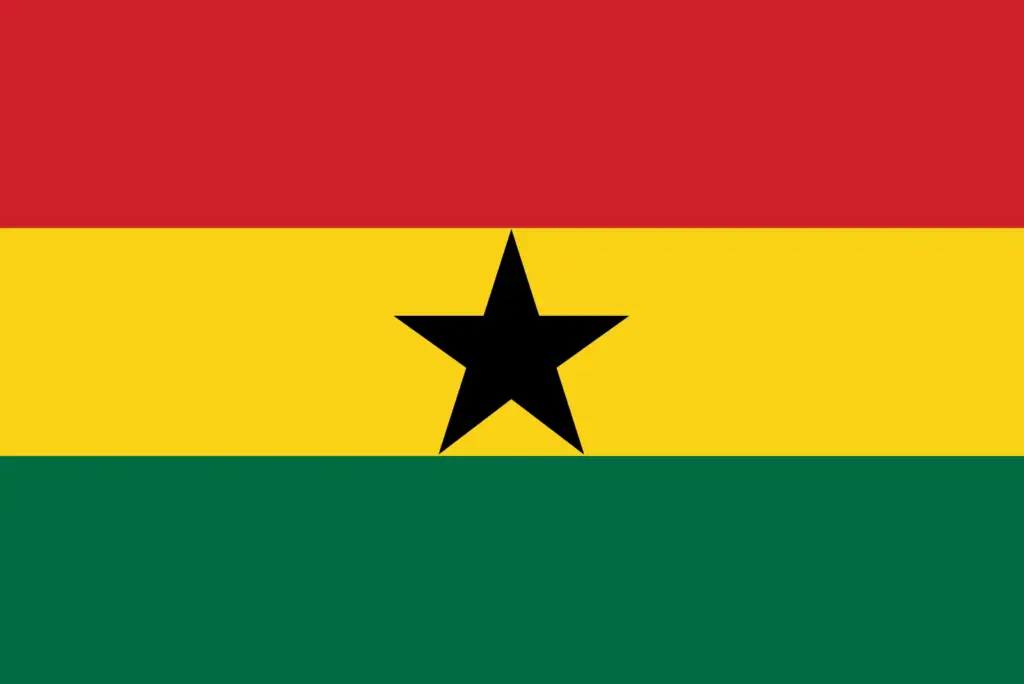
Embark on a delicious voyage through Ghana’s history, tasting how each era has left its mark on the country’s vibrant cuisine.
Ancient Origins: From Gondwanaland to Hunter-Gatherers
Imagine: millions of years ago, Ghana was part of the supercontinent Gondwanaland, nestled near South America! Fast forward to 5500 BC, and we discover evidence of our earliest culinary ancestors – hunter-gatherer communities thriving with their stone tools.
Empires Rise and Trade Flourishes
The mighty Ghana Empire (400-1240 AD) dominated the region, establishing bustling trade routes and a thriving society fueled by gold, but also sadly entangled in the slave trade.
Even before European interference, Ghana was a commercial hub, boasting established trade networks that laid the foundation for its diverse cuisine.
European Encounter: A New Chapter Begins
In 1471, Portuguese explorers, lured by the glimmer of gold jewelry worn by Ghanaians, arrived on the scene. Forts were built to trade for this precious metal, marking the start of a new chapter in Ghana’s history.
Soon, other European powers like the Dutch, English, Germans, and Danes joined the gold rush, further shaping the cultural and culinary landscape.
The Ashanti Empire: Golden Era of Culture and Cuisine
Around 1670, the powerful Ashanti Empire emerged, leaving an indelible mark on Ghanaian heritage. Gold trade remained central to their economy, centuries before European involvement.
This flourishing empire laid the groundwork for many traditional dishes and ingredients we enjoy today.
Post-Independence: Stability and a Flourishing Food Scene

In 1957, Ghana became the first sub-Saharan African nation to gain independence, ushering in a new era of stability and civil harmony. This peace and prosperity have allowed its unique culinary scene to flourish for over two decades.
Tasting Ghana: A Tapestry of Flavors
Staple Foods:
- Southern Ghana: Cassava and plantain reign supreme.
- Northern Ghana: Millet and sorghum hold center stage.
- Across the Nation: Yam, maize, beans, sweet potatoes, and cocoyam are beloved ingredients.
- Globalization’s Touch: Rice and wheat have also found their place on Ghanaian tables.
Traditional Delights:
- Akple: A delicious Ewe dish made from corn flour, often paired with okra soup or herring stew.
- Banku: A Ga Dangme favorite consisting of corn-cassava dough, typically served with various sauces.
Uniquely Ghanaian Flavors:
- European Influence: Rye bread, a legacy of European gold miners, adds a different dimension to the menu.
- Local Bounty: Ghana’s abundant rivers and lakes provide fresh fish and other ingredients, shaping its unique dishes.
A Final Bite
Ghanaian cuisine is a vibrant tapestry woven from history, tradition, and global influences. Each bite reflects the resilience and diversity of this remarkable nation. So, why not embark on your own culinary adventure and discover the delicious flavors of Ghana? 🇬🇭️
References
- This article on Ghana’s background, culture, and food is helpfull.
- worldhistory.org
- ghanaweb.com
- britannica.com
- en.wikipedia.org
- wanderlust.co.uk
- ghanaculture.gov.gh
- en.wikipedia.org
How the Geography and Climate has Affected Ghanian Cuisine

From the vibrant rivers teeming with fish to the fertile fields bursting with crops, Ghana’s unique geography and climate have deeply influenced its captivating cuisine.
Join us on a delicious exploration of how this nation’s land and history have shaped its distinct flavors:
Nature’s Bounty
- Freshwater Feast: Ghana’s numerous rivers and lakes offer an abundance of fish, a staple in Ghanaian diets. Imagine savory fish stews simmering with local spices, a gift from the country’s aquatic bounty.
- Tropical Tapestry: The warm and rainy climate nurtures lush vegetation, allowing for the cultivation of diverse crops. This rich tapestry of ingredients forms the very foundation of Ghanaian cuisine.
North & South: A Tale of Two Regions
- Southern Delights: With two rainy seasons, southern Ghana enjoys a surplus of agricultural possibilities. Farmers flourish, cultivating a wider variety of food compared to the north, which has only one rainy season.
- Northern Resilience: Despite facing longer dry periods due to erratic rainfall, indigenous communities in the north have adapted their farming practices, showcases remarkable resilience and ensuring food security.
Local Stars of the Plate
- Cassava King: This starchy root vegetable, widely grown across Ghana, features prominently in dishes like fufu, a comforting and versatile staple.
- Yam: A Versatile Hero: Another crucial player, yam’s versatility allows it to shine in various Ghanaian dishes, from stews to roasted delights.
- Plantain Power: These starchy bananas are essential for making banku, a cherished fermented dish loved for its unique texture and flavor.
- Palm Powerhouse: The palm tree provides palm oil, adding a distinct richness to soups and stews, a true taste of Ghana’s land.
A Changing Climate, Adapting Flavors
- Weather’s Impact: Climate change throws challenges, with erratic rainfall affecting the north’s crops and food availability. Yet, the spirit of Ghana shines through, with communities adapting their farming practices to ensure food security and cultural continuity.
Dishes that Speak of Place
- Fufu’s Humble Power: This starchy dish, made from cassava, yams, or plantains, embodies the resourcefulness and adaptability of Ghanaian cuisine. Boiled, pounded, and rolled into balls, it’s a comforting and versatile staple.
- Kenkey’s Fermented Goodness: Fermented cornmeal wrapped in plantain leaves or corn husks, kenkey offers a unique taste and texture, a testament to Ghana’s innovative culinary traditions.
- Groundnut Soup’s Savory Soul: This peanut-based soup, bursting with flavor, showcases the creative use of local ingredients and their transformation into hearty and delicious dishes.
Ghana’s cuisine is more than just food; it’s a vibrant tapestry woven from the threads of its land, history, and people. From bustling markets overflowing with fresh produce to family meals simmering with tradition, each bite tells a story of resilience, adaptation, and cultural richness. So, embark on your own culinary adventure and discover the unique flavors of Ghana!
References
- National Commission on Culture’s article on the Ghanaian kitchen.
- wfp.org
- digital.library.adelaide.edu.au
- frontiersin.org
- britannica.com
- doi.org
The Essence of Ghanian Cuisine

When it comes to Ghanian cuisine, the key to its flavorful and aromatic dishes lies in the country’s culinary traditions and cooking techniques. At the heart of Ghanian cooking, chefs use traditional Ghanian spices and seasonings like ginger, garlic, and cumin to create complex and layered flavors in stews, soups, and marinades. Beyond spices, the use of palm oil, coconut milk, and groundnut paste lend creaminess and depth to Ghanian dishes.
Ghanian cooking techniques are also essential to the cuisine’s unique flavors. One of the most popular cooking techniques in Ghanian cuisine is the use of clay pots to cook stews and soups, which provides a smoky and earthy flavor to the dish. “Banku and kenkey,” are a technique that chefs use in Ghanian cooking. These involve fermenting corn dough and cassava dough to make dishes that match with soups and stews.
Ghanian Culinary Traditions and Spices

Ghanian cooking is steeped in culinary traditions that have been passed down for generations. These traditions are reflected in the use of indigenous ingredients like yams, plantains, and cassava, which form the basis of many Ghanian dishes. In addition to these ingredients, traditional Ghanian spices like grains of paradise and scotch bonnet pepper are integral to the cuisine’s unique flavors and aromas.
Grains of paradise, also known as alligator pepper, are a versatile spice that are used to flavor a variety of dishes, from soups and stews to marinades and rubs. The scotch bonnet pepper, on the other hand, is a fiery chili pepper that is used to add heat to Ghanian dishes. The pepper is often used in its fresh or dried form and is a key ingredient in popular dishes like Jollof rice and red red.
Ghanian Cooking Techniques

Some of the most popular cooking techniques used in Ghanian cuisine include stewing, grilling, and frying. Stewing is a common cooking technique used to prepare hearty and flavorful stews and soups like groundnut soup and light soup.
Many recipes call for the popular technique of grilling to cook fish and meat, lending a smoky flavor to the dish. Many chefs fry ingredients to prepare popular street foods like Kelewele, which are spicy plantains.
Overall, the essence of Ghanian cuisine lies in its culinary traditions and cooking techniques. Chefs refine these over centuries to create a unique and flavorful cuisine. Whether you are a seasoned cook or a beginner in the kitchen, exploring Ghanian cuisine is a wonderful way to discover new flavors and aromas and expand your culinary horizons.
Staple Foods in Ghanian Cuisine

When it comes to Ghanian cuisine, there are certain staple dishes that are an integral part of the country’s food culture. Chefs prepare these dishes using traditional Ghanian ingredients and cooking methods. The result is a unique and flavorful taste that will excite your taste buds.
Fufu is a well-known staple of Ghanian cuisine. It is a starchy dish that has mashed yams, cassava, or plantains. They then form these into balls. Many chefs pair Fufu with soup or stew. Patrons eat it by using their fingers to scoop up the soup and fufu together.
A popular stable is Baku which uses fermented corn and cassava dough. Many chefs serve this dish alongside soup, stew and fish. Chefs usually make the dish by boiling water and gradually adding the corn and cassava mixture while stirring until it forms a dough-like consistency.
Jollof rice is another staple in Ghanian cuisine and is a popular dish throughout West Africa. The process involves using rice, tomatoes, onions, and a blend of spices. These result in a flavorful and aromatic dish that can patrons eat on its own or as a side dish to accompany meat, fish or vegetables.
Kenkey is a fermented corn-based dumpling. It is another staple dish that accompanies soup or stew and is a popular breakfast food in Ghana. It is made by soaking corn dough in water, fermenting it for a few days, then wrapping it in banana leaves and steaming it for several hours.
These staple dishes of Ghanian cuisine are just a few examples of the diverse and flavorful dishes that make up this rich culinary heritage. Whether you’re new to Ghanian cuisine or a seasoned enthusiast, these dishes are a must-try for anyone looking to experience traditional Ghanian food.
Meat and Fish in Ghanian Cuisine

Meat and fish are essential ingredients in Ghanian cuisine. From grilled tilapia to spicy goat stew, Ghanian cuisine offers a diverse range of dishes that cater to meat and fish lovers. In fact, some of the most popular Ghanian dishes use meat as the primary ingredient.
These include Jollof rice accompanying grilled chicken.
A favorite specialty in Ghana is grilled fish, particularly tilapia. Chefs often marinate this in a blend of spices including ginger, garlic, and cayenne pepper. They grill it to perfection on an open fire or over hot coals. This best way to enjoy this dish is with a side of banku.
This is a smooth and fluffy dumpling-like dish made from fermented corn and cassava dough.
Meat is Also an Important Staple
Another popular meat in Ghana is goat meat which chefs use in a variety of stews. A popular recipe is groundnut soup, made with peanuts, dried fish, and spices. Chefs often serve this hearty and flavorful dish with fufu, a starchy dough-like dish that they make from cassava and plantains.
For those who prefer beef, try the classic Ghanaian dish called red red, a spicy bean stew served with fried plantains. Additionally, chicken is a staple in Ghanian cuisine, often grilled or stewed and served with rice or banku.
When it comes to fish, Ghanian cuisine offers much more than just tilapia. Try the delicious smoked fish stew, which features a mix of smoked fish, tomatoes, onions, and spices, served with rice or kenkey, a steamed corn dough.
Another popular dish is the spicy fish balls, made from mashed fish, peppers, and spices and often served as a snack or appetizer.
Whether you prefer meat or fish, there is no shortage of flavorful and hearty dishes in Ghanian cuisine. These dishes showcase the diverse and rich culinary traditions of Ghana and are a must-try for anyone looking to experience authentic Ghanian cuisine.
Vegetarian and Vegan Options in Ghanian Cuisine

As a vegetarian or vegan, you might wonder if you can enjoy the rich flavors of Ghanian cuisine. The answer is a resounding yes! While meat and fish play prominent roles in Ghanian cooking, there are many delicious plant-based dishes that are a part of Ghanian food culture.
One of the most popular vegetarian dishes in Ghana is red-red, which is made with black-eyed peas, palm oil, and plantains. It’s a savory and satisfying dish that’s packed with flavor and nutrition. Another great option is groundnut soup, which is a peanut-based soup that’s creamy and comforting.
Vegan options also abound in Ghanian cuisine. Try banku with okra stew, a dish made with fermented cornmeal and a flavorful stew of okra, tomatoes, and spices. You can also try waakye, a dish made with rice and beans that’s typically served with a spicy pepper sauce and fried plantains.
Overall, you don’t have to miss out on the delicious tastes of Ghanian cuisine just because you follow a vegetarian or vegan diet. With a little bit of creativity and an open mind, you can enjoy the authentic flavors of traditional Ghanian food.
Popular Ghanian Street Foods

When it comes to experiencing the vibrant street food culture in Ghana, there are a few must-try dishes that you simply can’t miss. These popular Ghanian street foods are not only delicious but also offer a glimpse into the country’s rich culinary heritage.
Jollof Rice
Jollof rice is a popular dish not only in Ghana but also across West Africa. This one-pot meal is made with rice, tomatoes, onions, red pepper, and a range of aromatic spices. It’s typically served with fried plantains or steamed vegetables and is a filling and satisfying meal that can be enjoyed any time of the day.
Kelewele
If you’re a fan of spicy food, then Kelewele is a must-try street food in Ghana. These spicy fried plantains are seasoned with ginger, cayenne pepper, and other spices, giving them a sweet and spicy flavor. This dish is best enjoyed hot and fresh off the pan.
Bofrot
Bofrot, also known as puff puff, is a popular deep-fried snack in Ghana. Made with flour, sugar, yeast, and other ingredients, they are shaped into small balls and then deep-fried to a golden brown. Bofrot is often enjoyed as a breakfast or snack food and goes perfectly with a cup of hot tea or coffee.
Waakye
Waakye is a beloved dish in Ghana made with rice and beans. The dish is typically served with a spicy tomato and pepper sauce, fried plantains, and your choice of meat or fish. Waakye is a filling and flavorful meal and is commonly enjoyed as a lunchtime meal.
Kooko
For a refreshing and energizing drink, try kooko, a spicy and aromatic millet porridge. Made with millet, ginger, and other spices, Kooko is a popular breakfast beverage in Ghana and is believed to have medicinal properties.
These popular Ghanian street foods are just a few examples of the diverse and flavorful cuisine that Ghana has to offer. If you have the chance to explore the streets of Ghana, be sure to indulge in these delicious and authentic Ghanian dishes.
Traditional Ghanian Desserts
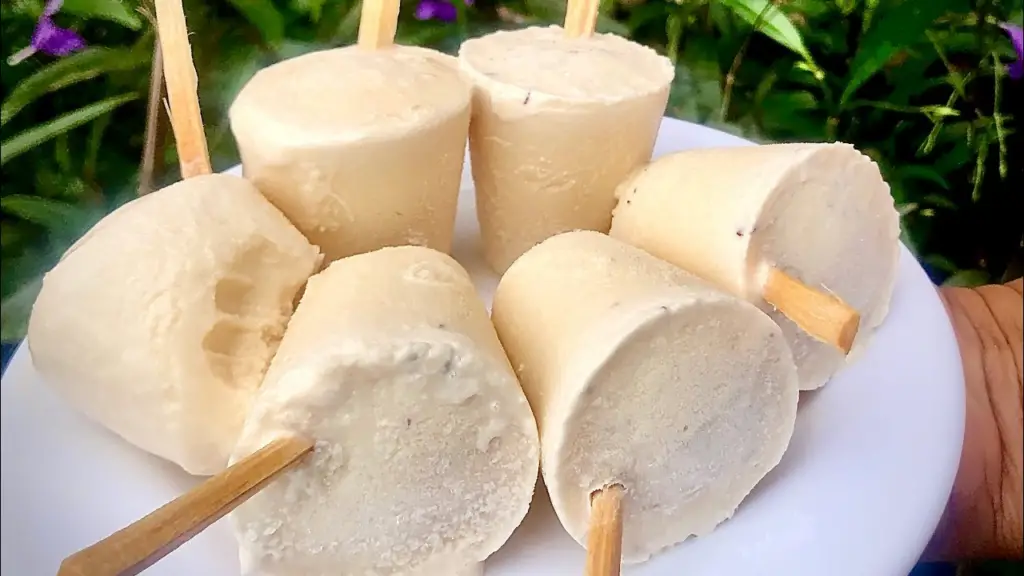
No meal is complete without a sweet treat, and Ghanian cuisine has a great selection of traditional desserts to satisfy your sweet tooth. The most popular is perhaps palm nut soup, made with palm nuts, meat, and spices.
It may sound more like a savory dish, but it is actually a sweet and rich soup served as a dessert. Another must-try is the refreshing coconut milk ice cream, made with coconut milk, fresh ginger, and cinnamon.
Ghanian desserts also feature a variety of puddings and cakes. One of the most beloved is groundnut soup, a peanut butter-based pudding topped with a sprinkle of cinnamon and served with a glass of refreshing hibiscus tea called Bissap.
If you’re looking for a lighter option, try fruit salad made with mangoes, pineapples, bananas, and papaya, all seasoned with lime and ginger, and garnished with toasted coconut flakes.
No matter which dessert you choose, you can be sure that it is made with fresh and authentic ingredients that reflect the culture and traditions of Ghanian cuisine.
Ghanian Beverages and Drinks

No meal is complete without a refreshing beverage, and Ghanian cuisine is no exception. Ghanian beverages and drinks are an essential part of the country’s food culture and offer a diverse range of flavors and aromas.
One of the most popular Ghanian drinks is bissap, a hibiscus tea that is often served chilled and sweetened with sugar. It has a tangy flavor and a bright red color that is sure to delight your taste buds.
Another beloved beverage is palm wine, made from the sap of palm trees. It is a light and refreshing drink with a slightly sweet and sour taste that pairs well with spicy Ghanian dishes.
If you’re looking for something a little spicier, try ginger beer. Made from fresh ginger root, this fizzy drink has a zingy flavor and is perfect for cooling off on a hot day.
And for something truly unique, try sobolo, a drink made from the dried flowers of the hibiscus plant. It has a vibrant red color and a fruity flavor that is both refreshing and satisfying.
Whether you’re looking for something sweet or spicy, Ghanian beverages and drinks offer a wide variety of options to explore.
Ghanian Cuisine: A Celebration of Diversity

As I’ve explored the wonderful world of Ghanian cuisine, I’ve discovered that it is a true celebration of diversity. From the coastal regions to the inland areas, Ghanian cuisine reflects the country’s rich cultural heritage and history.
Each region has its own unique dishes and ingredients, making it a delight to explore the different flavors and aromas of Ghanian food culture. Whether you’re savoring the spicy stews of the North or the succulent seafood of the South, Ghanian cuisine offers a diverse range of authentic dishes to try.
One of the things that I find most fascinating about Ghanian cuisine is how it blends different culinary traditions. From the influence of West African, European, and Arab cuisines, to the indigenous ingredients and cooking techniques of Ghana, Ghanian dishes are the result of a fusion of different cultures.
Despite this blend of influences, Ghanian cuisine remains true to its roots and continues to be a source of pride for Ghanaians both at home and abroad. It’s no wonder that authentic Ghanian dishes are gaining popularity among food enthusiasts worldwide!
Whether you’re intrigued by the bold flavors of Ghanian stews or the hearty satisfaction of traditional staples like fufu and banku, exploring Ghanian cuisine is sure to be a memorable culinary adventure.
How Healthy is Ghanian Food?

Ghanaian cuisine boasts a delicious and diverse array of dishes, reflecting the country’s rich cultural heritage and unique environment. However, labeling it as inherently healthy or unhealthy requires a nuanced approach, considering various factors:
Traditional Strengths
- Focus on fresh, local ingredients: Dishes often feature vegetables, fruits, legumes, and whole grains, providing essential vitamins, minerals, and fiber.
- Healthy cooking methods: Steaming, boiling, and grilling are prevalent, preserving nutrients better than deep-frying.
- Traditional spices and herbs: Ginger, turmeric, and chili peppers add flavor and potentially offer health benefits like anti-inflammatory properties.
Potential Downsides
- High reliance on starchy staples: Cassava, yam, and plantain, while offering energy, are high in carbohydrates and may lead to calorie or blood sugar concerns if consumed in excess.
- Palm oil usage: While a vital ingredient, palm oil is high in saturated fat, and its overuse can contribute to heart health risks.
- Salting and seasoning variations: Some dishes may be heavy on salt or contain hidden sodium, which can be a concern for those with blood pressure issues.
Overall Balance
- Ghanaian cuisine can be part of a healthy diet, emphasizing fresh ingredients, traditional cooking methods, and moderate portion sizes.
- Limiting the intake of palm oil or choosing sustainable, responsibly sourced options can minimize saturated fat intake.
- Balancing starchy staples with plenty of vegetables, fruits, and lean protein ensures a well-rounded nutritional profile.
- Being mindful of individual health needs and adjusting salt intake or choosing lower-sodium preparations is important.
Additional factors
- Individual variations in cooking styles and ingredient choices can significantly impact a dish’s healthfulness.
- Access to fresh, high-quality ingredients plays a crucial role in maintaining a healthy diet.
- Cultural context and personal preferences around food should be considered when discussing healthfulness.
Takeaway
Ghanaian food offers a wealth of delicious and culturally significant dishes. By understanding its strengths and potential downsides, individuals can make informed choices to incorporate it into a healthy and balanced diet that suits their needs and preferences.
Remember, it’s always best to consult with a healthcare professional or registered dietitian for personalized dietary advice.
Bringing the Taste of Ghana to Your Kitchen

Are you ready to bring the authentic flavors of Ghana into your own kitchen? Let’s dive into traditional Ghanian recipes and cooking techniques that will take you on a culinary journey to West Africa.
Whether you’re a seasoned cook or a beginner in the kitchen, Ghanian cuisine offers a range of dishes that are easy to make and bursting with flavor. Start with simple recipes like Jollof rice or kenkey, a staple food made from fermented corn that is perfect for accompanying stews and sauces.
For those who prefer meat or fish dishes, try recreating popular dishes like grilled tilapia or goat stew made with traditional Ghanian spices like grains of paradise, ginger and scotch bonnet pepper. For vegetarians or vegans, explore the plant-based options like banku with okra soup or fufu with peanut soup that are a part of Ghanian food culture.
But it’s not just the ingredients that make Ghanian cuisine special. Traditional cooking techniques like using a mortar and pestle to grind spices or steaming food in banana leaves add depth and flavor to the dishes that you simply cannot replicate with modern kitchen gadgets.
So why not give it a try? Head to a local African food market or specialty store to find authentic Ghanian ingredients and start experimenting with traditional Ghanian cooking techniques. Whether you’re looking to explore new flavors, impress your dinner guests or simply broaden your culinary horizons, Ghanian cuisine offers something for everyone.
Ghana Food – Akple (A Delicious Ewe Dish Made from Corn Flour)

Akple – A Delicious Ewe Dish Made From Corn Flour
Hey, foodies! Today, let’s embark on a culinary adventure to explore the flavors of Ghana with a traditional dish called Akple. This mouthwatering Ewe dish is a staple in the Volta Region, where it has been cherished for generations.
Join me in discovering the history and savoring the taste of this delightful corn flour creation!
History and Background: Akple is a traditional dish of the Ewe people in the Volta Region of Ghana. The word “Akple” is derived from the Ewe language, and the dish holds cultural significance in ceremonies, festivals, and everyday meals.
Typically served with hot pepper sauce and a variety of soups, Akple is a symbol of communal sharing and celebration in Ewe communities.
Ghana Food – Akple Ingredients
- 2 cups corn flour
- 1 cup cassava dough
- Water
- Salt to taste
Akple Preparation – Ingredients:
- Combine Dry Ingredients:
- In a large mixing bowl, combine the corn flour and cassava dough.
- Add Water:
- Gradually add water to the dry mixture, stirring continuously to avoid lumps. Continue until you achieve a smooth, thick consistency.
- Season with Salt:
- Add salt to taste, ensuring it’s well-distributed throughout the batter.
- Cook Cassava Leaves (Optional):
- In some variations, Akple is served with cooked cassava leaves. If desired, prepare the leaves separately.
Ghana Food – Akple Recipe – Akple: Serves 4 | Estimated Cooking Time: 30 minutes | Nutritional Information: (per serving)
- Prepare the Batter:
- In a large mixing bowl, combine 2 cups of corn flour and 1 cup of cassava dough.
- Gradually add water and stir until you achieve a smooth, thick consistency.
- Season and Salt:
- Add salt to taste, making sure it’s evenly distributed throughout the batter.
- Form Ball Shapes:
- Wet your hands to prevent sticking, then take portions of the batter and form them into smooth ball shapes.
- Cook in Simmering Water:
- Bring a pot of water to a gentle simmer.
- Carefully place the formed Akple balls into the simmering water and cook for about 15-20 minutes or until they float to the surface.
- Serve Hot:
- Remove the cooked Akple from the water, let them drain, and serve hot.
Nutritional Information:
- Calories: 180 per serving
- Protein: 4g
- Fat: 1g
- Carbohydrates: 40g
- Fiber: 2g
Experience the warmth and tradition of the Volta Region with this delightful Akple dish. It’s not just a meal; it’s a journey into the heart of Ghanaian culinary heritage. Enjoy the flavors! Guten Appetit
Ghana Food – Fish Stew

History and Background: Fish Stew holds a special place in Ghanaian cuisine, especially along the coastal areas. With the Atlantic Ocean on its doorstep, Ghana is blessed with an abundance of fresh fish, making this stew a celebration of local ingredients and culinary traditions.
The blend of aromatic spices and fresh seafood paints a delicious picture of the coastal life in Ghana.
Fish Stew Ingredients
- 1 lb fish fillets (tilapia or any firm white fish)
- 2 cups tomatoes, diced
- 1 large onion, chopped
- 2 cloves garlic, minced
- 1 thumb-sized ginger, grated
- 1 bell pepper, chopped
- 1 hot pepper (scotch bonnet or habanero), chopped (adjust for spice preference)
- 1 cup tomato paste
- 1 cup fish or vegetable broth
- 2 tablespoons vegetable oil
- 1 teaspoon ground cayenne pepper
- Salt and pepper to taste
- Fresh herbs for garnish (optional)
Ghana Food – Fish Stew Ingredients – Detailed
- Fish:
- 1 lb fish fillets (tilapia or any firm white fish)
- Vegetables:
- 2 cups tomatoes, diced
- 1 large onion, chopped
- 1 bell pepper, chopped
- 1 hot pepper (scotch bonnet or habanero), chopped (adjust for spice preference)
- Aromatics:
- 2 cloves garlic, minced
- 1 thumb-sized ginger, grated
- Sauce Base:
- 1 cup tomato paste
- 1 cup fish or vegetable broth
- Seasonings:
- 1 teaspoon ground cayenne pepper
- Salt and pepper to taste
- Cooking Oil:
- 2 tablespoons vegetable oil
- Garnish:
- Fresh herbs for garnish (optional)
Ghana Food – Recipe – Fish Stew: Serves 4 | Estimated Cooking Time: 40 minutes | Nutritional Information: (per serving)
- Prepare Ingredients:
- Clean and cut the fish fillets into bite-sized pieces.
- Dice tomatoes, chop onions, bell pepper, and hot pepper.
- Mince garlic and grate ginger.
- Sauté Aromatics:
- In a large pot, heat vegetable oil over medium heat.
- Sauté onions, garlic, and ginger until fragrant.
- Build the Base:
- Add diced tomatoes, bell pepper, and hot pepper. Cook until the vegetables soften.
- Add Tomato Paste and Broth:
- Stir in tomato paste and fish or vegetable broth. Mix well to form a thick, rich base.
- Season and Simmer:
- Add ground cayenne pepper, salt, and pepper to taste.
- Gently place fish pieces into the stew and simmer for about 15-20 minutes until the fish is cooked through.
- Garnish and Serve:
- Garnish with fresh herbs if desired.
- Serve the Fish Stew hot, paired with rice or your favorite side.
Nutritional Information
- Calories: 250 per serving
- Protein: 25g
- Fat: 8g
- Carbohydrates: 18g
- Fiber: 4g
Get ready to savor the flavors of Ghana with this Fish Stew recipe. It’s a taste of the coastal breeze right in your home kitchen. Enjoy the culinary journey! Guten Appetit!
Ghana Food – Groundnut Soup

Exploring Ghanaian Culinary Delights: Groundnut Soup
Greetings, foodies! Today, we embark on a flavorful journey to the heart of West Africa – Ghana. Known for its rich cultural tapestry and diverse cuisine, Ghana offers a culinary adventure like no other. One dish that stands out is the beloved Groundnut Soup.
Rooted in tradition, this soup is a delicious blend of local flavors, featuring peanuts as a key ingredient. Get ready to experience the warmth and authenticity of Ghanaian cuisine right in your own kitchen!
Ghana Food – Groundnut Soup Ingredients
- 2 cups roasted peanuts
- 1 pound chicken, cut into pieces
- 1 cup chopped tomatoes
- 1 medium-sized onion, finely chopped
- 2 cloves garlic, minced
- 1 thumb-sized ginger, grated
- 1 cup okra, sliced
- 2 medium-sized eggplants, diced
- 1 cup spinach leaves
- 2 tablespoons palm oil
- 1 teaspoon ground crayfish
- 1 teaspoon ground pepper
- Salt to taste
- 6 cups chicken broth
- 2 tablespoons tomato paste
Ghana Food – Groundnut Soup Recipe
1. Prepare the Peanut Base:
- Grind the roasted peanuts into a smooth paste using a food processor or mortar and pestle.
- In a large pot, heat the palm oil over medium heat. Add the chopped onions, garlic, and ginger. Sauté until fragrant.
2. Build the Flavor:
- Add the chicken pieces to the pot and brown them on all sides.
- Stir in the ground crayfish, ground pepper, and tomato paste. Cook for 2-3 minutes until well combined.
3. Simmer the Soup:
- Pour in the chicken broth and bring the mixture to a gentle boil. Reduce the heat and let it simmer for about 15 minutes, allowing the flavors to meld.
4. Add Vegetables:
- Toss in the chopped tomatoes, okra, and diced eggplants. Simmer for an additional 10-15 minutes until the vegetables are tender.
5. Integrate the Peanut Paste:
- Gradually add the peanut paste to the pot, stirring continuously to avoid lumps. Let it simmer for another 10-15 minutes until the soup thickens.
6. Finish with Greens:
- Gently fold in the spinach leaves and cook until wilted. Season the soup with salt to taste.
7. Serve and Enjoy:
- Ladle the Groundnut Soup into bowls and serve it hot with a side of your favorite rice or fufu. Garnish with chopped fresh herbs if desired.
Serving:
This recipe serves 6 people.
Estimated Cooking Time:
Approximately 1 hour and 30 minutes.
Nutritional Information:
- Calories per serving: 400 kcal
- Protein: 25g
- Carbohydrates: 15g
- Fat: 30g
- Fiber: 5g
Get ready to savor the incredible flavors of Ghana with this authentic Groundnut Soup recipe. It’s a true celebration of West African culinary excellence!
Ghana Food – Boiled yam or plantain with Kontomire stew

Savoring Ghana’s Staple Dish: Boiled Yam or Plantain with Kontomire Stew
Hello, food enthusiasts! Today, we’re diving into the heart of Ghanaian cuisine with a classic and hearty dish – Boiled Yam or Plantain with Kontomire Stew. This traditional meal is a beloved staple, celebrated for its rich flavors and cultural significance.
Join me as we explore the roots of this dish and create a delicious, wholesome meal that brings the essence of Ghana to your table.
Ghana Food – Boiled yam or plantain with Kontomire stew Ingredients
Boiled Yam or Plantain:
- 4 large yams or plantains (ripe or unripe)
- Water for boiling
- Salt to taste
Kontomire Stew:
- 2 cups kontomire (cocoyam) leaves, washed and chopped
- 1 cup palm oil
- 1 large onion, finely chopped
- 2 large tomatoes, diced
- 2 cloves garlic, minced
- 1 thumb-sized ginger, grated
- 2 tablespoons ground crayfish
- 2 teaspoons ground pepper (adjust to taste)
- Salt to taste
- Optional: 1 cup smoked or grilled mackerel, deboned and flaked
Ghana Food – Boiled yam or plantain with Kontomire stew Recipe:
1. Boil Yam or Plantain:
- Peel and cut the yams or plantains into manageable chunks.
- In a pot, bring water to a boil, add salt, and boil the yams or plantains until they are fork-tender.
2. Prepare Kontomire Stew:
- In a separate pot, heat the palm oil over medium heat.
- Add chopped onions and sauté until translucent.
3. Add Aromatics:
- Stir in minced garlic and grated ginger, allowing the mixture to cook for 2-3 minutes until fragrant.
4. Incorporate Tomatoes and Kontomire:
- Add diced tomatoes to the pot, cooking until they are soft and form a thick base.
- Stir in the chopped kontomire leaves and cook until wilted.
5. Season the Stew:
- Season the stew with ground crayfish, ground pepper, and salt to taste. Adjust the spice level to your preference.
6. Optional: Add Mackerel:
- If using smoked or grilled mackerel, add it to the stew and mix well. Allow it to simmer for an additional 5 minutes.
7. Serve:
- Plate the boiled yam or plantain and generously ladle the Kontomire Stew over the top. Serve hot and enjoy the harmonious flavors.
Serving: This recipe serves 4 people.
Estimated Cooking Time: Approximately 45 minutes.
Nutritional Information:
- Calories per serving: 400 kcal
- Protein: 5g
- Carbohydrates: 40g
- Fat: 25g
- Fiber: 6g
Celebrate the heartiness of Ghanaian cuisine with Boiled Yam or Plantain with Kontomire Stew – a dish that reflects the warmth and flavor of West African traditions.
Ghana Food – Spicy Goat Stew

Exploring Ghana’s Culinary Heritage: Spicy Goat Stew
Greetings, fellow food enthusiasts! Today, we embark on a delightful journey through the vibrant flavors of West Africa, specifically Ghana. Known for its rich cultural diversity and culinary excellence, Ghanaian cuisine is a feast for the senses.
Our spotlight today is on the Spicy Goat Stew – a hearty dish that encapsulates the bold and robust flavors of the region. Join me as we dive into the history and prepare this authentic Ghanaian delight in the comfort of your own kitchen!
Ghana Food – Spicy Goat Stew Ingredients
- 2 pounds goat meat, cubed
- 2 large onions, finely chopped
- 4 tomatoes, diced
- 2 bell peppers, sliced
- 4 cloves garlic, minced
- 1 thumb-sized ginger, grated
- 2 tablespoons vegetable oil
- 2 tablespoons tomato paste
- 2 teaspoons ground cayenne pepper
- 1 teaspoon ground coriander
- 1 teaspoon ground cumin
- 1 teaspoon paprika
- Salt and pepper to taste
- 4 cups beef or vegetable broth
- 4 medium-sized potatoes, peeled and diced
- Fresh cilantro for garnish (optional)
Ghana Food – Spicy Goat Stew Recipe:
1. Marinate the Goat Meat:
- In a large bowl, combine the cubed goat meat with half of the chopped onions, minced garlic, grated ginger, ground cayenne pepper, ground coriander, ground cumin, paprika, salt, and pepper. Let it marinate for at least 30 minutes.
2. Sear the Goat Meat:
- Heat vegetable oil in a large pot over medium-high heat. Add the marinated goat meat and sear until browned on all sides.
3. Build the Flavor Base:
- Stir in the remaining chopped onions, diced tomatoes, and sliced bell peppers. Cook until the vegetables are softened.
4. Add Tomato Paste:
- Incorporate the tomato paste into the pot, stirring well to blend. Allow it to cook for 2-3 minutes to deepen the flavors.
5. Pour in Broth:
- Pour in the beef or vegetable broth, ensuring it covers the meat and vegetables. Bring the stew to a simmer, then reduce the heat to low.
6. Simmer and Add Potatoes:
- Let the stew simmer for approximately 1 to 1.5 hours, allowing the goat meat to become tender. Add diced potatoes and continue simmering until they are cooked through.
7. Adjust Seasoning and Serve:
- Taste and adjust the seasoning as needed. Serve the Spicy Goat Stew hot, garnished with fresh cilantro if desired.
Serving: This recipe serves 6 people.
Estimated Cooking Time: Approximately 2 hours.
Nutritional Information:
- Calories per serving: 400 kcal
- Protein: 30g
- Carbohydrates: 25g
- Fat: 20g
- Fiber: 5g
Get ready to experience the bold and aromatic flavors of Ghana with this Spicy Goat Stew. It’s a celebration of West African culinary traditions right in your own home!
Ghana Food – Chicken

Discovering Ghanaian Flavors: Authentic Ghanaian Chicken Stew
Greetings, foodies! Today, we’re venturing into the heart of West Africa with a recipe that embodies the soulful and rich culinary heritage of Ghana. The Ghanaian Chicken Stew is a delightful medley of spices, colors, and textures, bringing together the diverse flavors of the region.
Join me as we explore the history and prepare this authentic dish that captures the essence of Ghanaian home cooking.
Ghana Food – Chicken Ingredients:
- 2 pounds chicken, cut into pieces
- 2 large onions, finely chopped
- 3 tomatoes, diced
- 2 bell peppers, sliced
- 4 cloves garlic, minced
- 1 thumb-sized ginger, grated
- 2 tablespoons vegetable oil
- 2 tablespoons tomato paste
- 1 teaspoon ground cayenne pepper
- 1 teaspoon ground coriander
- 1 teaspoon ground cumin
- 1 teaspoon paprika
- Salt and pepper to taste
- 4 cups chicken broth
- 4 medium-sized carrots, peeled and sliced
- Fresh parsley for garnish (optional)
Ghana Food – Chicken Recipe:
1. Marinate the Chicken:
- In a large bowl, combine the chicken pieces with half of the chopped onions, minced garlic, grated ginger, ground cayenne pepper, ground coriander, ground cumin, paprika, salt, and pepper. Allow it to marinate for at least 30 minutes.
2. Sauté the Chicken:
- Heat vegetable oil in a large pot over medium-high heat. Add the marinated chicken and brown on all sides.
3. Build Flavor with Vegetables:
- Add the remaining chopped onions, diced tomatoes, and sliced bell peppers to the pot. Cook until the vegetables soften.
4. Incorporate Tomato Paste:
- Stir in the tomato paste, ensuring it blends well with the ingredients. Cook for an additional 2-3 minutes.
5. Add Chicken Broth:
- Pour in the chicken broth, covering the chicken and vegetables. Bring the stew to a simmer, then reduce the heat to low.
6. Simmer and Add Carrots:
- Allow the stew to simmer for approximately 45 minutes to 1 hour, letting the flavors meld. Add sliced carrots and continue simmering until they are tender.
7. Adjust Seasoning and Serve:
- Taste and adjust the seasoning as needed. Serve the Ghanaian Chicken Stew hot, garnished with fresh parsley if desired.
Serving: This recipe serves 6 people.
Estimated Cooking Time: Approximately 1 hour and 15 minutes.
Nutritional Information:
- Calories per serving: 350 kcal
- Protein: 25g
- Carbohydrates: 20g
- Fat: 15g
- Fiber: 4g
Embrace the warmth and flavor of Ghanaian hospitality with this Authentic Chicken Stew. It’s a taste of West Africa that you can savor in the comfort of your own kitchen!
Ghana Food – Spicy Fish Balls, Made from Mashed Fish, Peppers, And Spices

Exploring the Culinary Charms of Ghana: Spicy Fish Balls
Greetings, food enthusiasts! Today, we’re embarking on a flavorful journey to Ghana, a country on the west coast of Africa with a rich tapestry of culture and cuisine. Our focus is on a beloved Ghanaian dish – Spicy Fish Balls.
Crafted from mashed fish, peppers, and an array of spices, these delectable bites offer a perfect blend of savory and spicy flavors. Join me as we dive into the history and recreate this delightful Ghanaian treat in your own kitchen!
Ghana Food – Spicy Fish Balls Ingredients:
- 1 pound white fish fillets (tilapia or catfish), deboned
- 1 medium-sized onion, finely chopped
- 2 cloves garlic, minced
- 1 thumb-sized ginger, grated
- 2 tablespoons chopped fresh cilantro
- 2 green chilies, finely chopped
- 1 teaspoon ground cayenne pepper
- 1 teaspoon ground coriander
- 1 teaspoon ground cumin
- Salt and pepper to taste
- 2 tablespoons vegetable oil for frying
- 1 cup breadcrumbs (for coating)
- Fresh lime wedges for serving
Ghana Food – Spicy Fish Balls Recipe:
1. Prepare the Fish Mixture:
- In a food processor, combine the white fish fillets, chopped onion, minced garlic, grated ginger, chopped cilantro, green chilies, ground cayenne pepper, ground coriander, ground cumin, salt, and pepper. Blend until you achieve a smooth, well-mixed consistency.
2. Shape the Fish Balls:
- Scoop out small portions of the fish mixture and roll them into bite-sized balls using your hands. Ensure they are evenly shaped for even cooking.
3. Coat with Breadcrumbs:
- Roll each fish ball in breadcrumbs, coating them evenly. This step adds a delightful crunch to the outside of the fish balls.
4. Heat Vegetable Oil:
- In a frying pan, heat the vegetable oil over medium-high heat. Ensure the oil is hot but not smoking.
5. Fry the Fish Balls:
- Carefully place the coated fish balls into the hot oil, frying them until they turn golden brown on all sides. This usually takes about 3-4 minutes.
6. Drain and Serve:
- Once the fish balls are cooked, remove them from the oil and place them on a paper towel to drain excess oil.
7. Garnish and Enjoy:
- Serve the Spicy Fish Balls hot with fresh lime wedges for a zesty kick. Garnish with additional cilantro if desired.
Serving: This recipe makes approximately 20 fish balls.
Estimated Cooking Time: Approximately 30 minutes.
Nutritional Information:
- Calories per serving (3 fish balls): 150 kcal
- Protein: 12g
- Carbohydrates: 10g
- Fat: 7g
- Fiber: 1g
Get ready to savor the bold and spicy flavors of Ghana with these homemade Spicy Fish Balls. It’s a delightful snack that captures the essence of West African cuisine!
Ghana Food – Fruit Salad Made with Mangoes, Pineapples, Bananas, And Papaya, All Seasoned with Lime and Ginger, and Garnished with Toasted Coconut Flakes

Exploring Ghana’s Tropical Bounty: Refreshing Fruit Salad with a Ghanaian Twist
Hello, fellow food enthusiasts! Today, we’re venturing into the lush landscapes of Ghana, where vibrant fruits come together to create a refreshing delight – Ghanaian Fruit Salad.
Bursting with flavors of mangoes, pineapples, bananas, and papaya, this salad is elevated with a zesty kick from lime and ginger.
Join me on this culinary escapade as we explore the history and craft this tropical treat that embodies the essence of Ghana’s bountiful harvest.
Ghana Food – Fruit Salad Ingredients:
- 2 ripe mangoes, peeled and diced
- 1 small pineapple, peeled and diced
- 3 ripe bananas, sliced
- 1 medium-sized papaya, peeled, seeded, and diced
- Juice of 2 limes
- 1 tablespoon grated ginger
- 2 tablespoons honey
- 1/4 cup toasted coconut flakes for garnish
Ghana Food – Fruit Salad Recipe:
1. Prepare the Fruits:
- Peel and dice the mangoes, pineapple, and papaya. Slice the bananas.
2. Combine Fruits in a Bowl:
- In a large bowl, gently combine the diced mangoes, pineapple, bananas, and papaya. Ensure an even distribution of fruits for a balanced bite.
3. Prepare the Dressing:
- In a small bowl, whisk together the lime juice, grated ginger, and honey. This zesty dressing adds a delightful twist to the fruit salad.
4. Drizzle Dressing over Fruits:
- Pour the lime and ginger dressing over the mixed fruits. Gently toss to coat the fruits evenly with the dressing.
5. Chill in the Refrigerator:
- Place the fruit salad in the refrigerator for at least 30 minutes to allow the flavors to meld and the salad to chill.
6. Toast Coconut Flakes:
- In a dry pan over medium heat, toast the coconut flakes until golden brown. Keep a close eye on them to prevent burning.
7. Garnish and Serve:
- Before serving, sprinkle the toasted coconut flakes over the fruit salad for a delightful crunch and added flavor.
Serving: This recipe serves 4-6 people.
Estimated Preparation Time: Approximately 15 minutes.
Nutritional Information:
- Calories per serving: 120 kcal
- Protein: 1g
- Carbohydrates: 30g
- Fat: 1g
- Fiber: 3g
Indulge in the tropical goodness of Ghanaian Fruit Salad, a perfect blend of sweetness and zest. It’s a vibrant and healthy addition to any meal or a delightful standalone treat!
Ghana Food – Peanut Brittle

Discovering Ghana’s Sweet Heritage: Irresistible Peanut Brittle
Hello, fellow foodies! Today, we’re delving into the sweet traditions of Ghana with a delightful treat – Peanut Brittle. Rooted in the rich culinary tapestry of West Africa, this crunchy and nutty confectionery has been a favorite for generations.
Join me as we explore the history and craft this easy-to-make Ghanaian delight that’s perfect for satisfying your sweet cravings!
Ghana Food – Peanut Brittle Ingredients:
- 1 cup unsalted peanuts
- 1 cup granulated sugar
- 1/2 cup water
- 2 tablespoons unsalted butter
- 1 teaspoon vanilla extract
- 1/2 teaspoon baking soda
- A pinch of salt
Ghana Food – Peanut Brittle Recipe:
1. Prepare Baking Sheet:
- Line a baking sheet with parchment paper and set it aside.
2. Roast Peanuts:
- In a dry skillet over medium heat, roast the peanuts until they are golden brown and fragrant. Set aside.
3. Create Sugar Syrup:
- In a saucepan, combine granulated sugar and water. Stir over medium heat until the sugar dissolves.
4. Cook Sugar Syrup:
- Allow the sugar syrup to come to a boil, then let it simmer without stirring until it reaches a rich amber color. This usually takes about 10-15 minutes.
5. Add Butter and Peanuts:
- Carefully stir in the unsalted butter and roasted peanuts into the sugar syrup, combining them thoroughly.
6. Flavor with Vanilla:
- Remove the pan from heat and stir in the vanilla extract, baking soda, and a pinch of salt. The baking soda will create a light and airy texture.
7. Spread on Baking Sheet:
- Quickly pour the peanut mixture onto the prepared baking sheet, spreading it into an even layer with a spatula.
8. Cool and Break into Pieces:
- Allow the peanut brittle to cool completely. Once set, break it into bite-sized pieces.
Serving: This recipe yields approximately 8 servings.
Estimated Cooking Time: Approximately 30 minutes.
Nutritional Information:
- Calories per serving: 200 kcal
- Protein: 5g
- Carbohydrates: 25g
- Fat: 10g
- Fiber: 2g
Indulge in the irresistible taste of Ghana with this homemade Peanut Brittle. Whether as a sweet treat for yourself or a delightful gift for friends, it’s a snack that captures the essence of West African sweetness!
Ghana Food – Condensed Milk Toffee

Exploring the Sweet Side of Ghana: Condensed Milk Toffee
Hey there, fellow food enthusiasts! Today, we’re diving into the delightful world of Ghanaian sweets with a classic treat – Condensed Milk Toffee. Rooted in the culinary traditions of West Africa, this toffee boasts a perfect balance of sweetness and creaminess that will surely satisfy your sweet tooth.
Join me as we uncover the history and whip up this easy-to-make Ghanaian delight in the comfort of your own kitchen!
Ghana Food – Condensed Milk Toffee Ingredients:
- 1 cup unsalted butter
- 1 cup granulated sugar
- 1 can (14 ounces) sweetened condensed milk
- 1 teaspoon vanilla extract
- A pinch of salt
Ghana Food – Condensed Milk Toffee Recipe:
1. Prepare Baking Pan:
- Line a square baking pan with parchment paper, leaving some overhang for easy removal. Set aside.
2. Melt Butter:
- In a saucepan over medium heat, melt the unsalted butter.
3. Add Sugar and Condensed Milk:
- Once the butter is melted, add the granulated sugar and sweetened condensed milk to the saucepan. Stir continuously to combine.
4. Cook to Soft-Ball Stage:
- Bring the mixture to a boil, stirring constantly. Use a candy thermometer to monitor the temperature. Cook until it reaches the soft-ball stage, around 235-240°F (113-116°C). This usually takes about 10-15 minutes.
5. Add Vanilla and Salt:
- Remove the saucepan from heat and stir in the vanilla extract and a pinch of salt. Mix well.
6. Pour into Baking Pan:
- Quickly pour the toffee mixture into the prepared baking pan, spreading it evenly.
7. Allow to Cool:
- Let the toffee cool at room temperature for about 2 hours or until fully set.
8. Cut into Pieces:
- Once the toffee is set, use a sharp knife to cut it into bite-sized pieces.
Serving: This recipe makes approximately 24 pieces of toffee.
Estimated Cooking Time: Approximately 25 minutes.
Nutritional Information:
- Calories per serving (1 piece): 120 kcal
- Protein: 1g
- Carbohydrates: 15g
- Fat: 7g
- Fiber: 0g
Enjoy the sweet sensation of Ghanaian Condensed Milk Toffee – a delicious reminder of the rich and delightful sweets found in West African cuisine!
Ghana Food – Ripe Plantain Cake

Embracing Tropical Sweetness: Ripe Plantain Cake
Hello, fellow foodies! Today, let’s take a flavorful journey to the tropics with a twist on a classic dessert – Ripe Plantain Cake. Originating from the lush regions of West Africa, particularly Ghana, this cake celebrates the natural sweetness and versatility of ripe plantains.
Join me as we explore the history of this delightful treat and whip up a moist and indulgent plantain cake that’s perfect for any occasion.
Ghana Food – Ripe Plantain Cake Ingredients:
- 3 ripe plantains, peeled and mashed
- 1 cup all-purpose flour
- 1 teaspoon baking powder
- 1/2 teaspoon baking soda
- 1/4 teaspoon salt
- 1/2 cup unsalted butter, softened
- 1 cup brown sugar
- 2 large eggs
- 1 teaspoon vanilla extract
- 1/2 cup plain yogurt
- 1/2 cup chopped walnuts or pecans (optional)
- Cooking spray or additional butter for greasing the pan
Ghana Food – Ripe Plantain Cake Recipe:
1. Preheat the Oven:
- Preheat your oven to 350°F (180°C). Grease a 9-inch round cake pan with cooking spray or butter.
2. Prepare the Plantains:
- Peel and mash the ripe plantains in a bowl. Set aside.
3. Mix Dry Ingredients:
- In a separate bowl, whisk together the all-purpose flour, baking powder, baking soda, and salt.
4. Cream Butter and Sugar:
- In a large mixing bowl, cream together the softened butter and brown sugar until light and fluffy.
5. Add Eggs and Vanilla:
- Beat in the eggs one at a time, ensuring each is fully incorporated. Add the vanilla extract and mix well.
6. Combine Wet and Dry Ingredients:
- Gradually add the mashed plantains to the wet mixture, followed by the dry ingredients. Mix until just combined.
7. Add Yogurt and Nuts:
- Fold in the plain yogurt and chopped nuts (if using) until evenly distributed throughout the batter.
8. Bake the Cake:
- Pour the batter into the prepared cake pan, spreading it evenly. Bake in the preheated oven for 45-50 minutes or until a toothpick inserted into the center comes out clean.
9. Cool and Serve:
- Allow the cake to cool in the pan for 10 minutes before transferring it to a wire rack to cool completely. Once cooled, slice and serve.
Serving: This recipe yields approximately 10 servings.
Estimated Cooking Time: Approximately 50 minutes.
Nutritional Information:
- Calories per serving: 280 kcal
- Protein: 4g
- Carbohydrates: 40g
- Fat: 12g
- Fiber: 2g
Indulge in the tropical sweetness of Ripe Plantain Cake – a dessert that brings the warm flavors of West Africa to your table!
Ghana Food – Ghanian Pancakes

Embracing Ghana’s Breakfast Tradition: Ghanian Pancakes
Hello, breakfast enthusiasts! Today, let’s dive into the rich culinary tapestry of Ghana with a twist on a classic morning delight – Ghanian Pancakes. Originating from the vibrant West African region, these pancakes are a celebration of flavors and simplicity.
Join me as we explore the history of this beloved breakfast and whip up a stack that will transport you to the lively streets of Ghana.
Ghana Food – Ghanian Pancakes Ingredients
- 2 cups all-purpose flour
- 2 tablespoons sugar
- 2 teaspoons baking powder
- 1/4 teaspoon salt
- 2 large eggs
- 1 1/2 cups milk
- 2 tablespoons melted butter
- 1 teaspoon vanilla extract
- Cooking oil or butter for greasing the pan
- Maple syrup and fresh fruit for serving (optional)
Ghana Food – Ghanian Pancakes Recipe
1. Mix Dry Ingredients:
- In a large mixing bowl, whisk together the all-purpose flour, sugar, baking powder, and salt.
2. Beat Eggs:
- In a separate bowl, beat the eggs until well combined.
3. Combine Wet Ingredients:
- To the beaten eggs, add milk, melted butter, and vanilla extract. Mix well.
4. Create Batter:
- Pour the wet ingredients into the dry ingredients and stir until just combined. Don’t overmix; a few lumps are okay.
5. Heat Pan:
- Heat a non-stick skillet or griddle over medium heat. Add a little cooking oil or butter to coat the surface.
6. Cook Pancakes:
- Scoop 1/4 cup of batter onto the hot skillet for each pancake. Cook until bubbles form on the surface, then flip and cook the other side until golden brown.
7. Keep Warm:
- As you cook, place the finished pancakes on a plate and cover them with a clean kitchen towel to keep them warm.
8. Serve and Enjoy:
- Serve the Ghanian Pancakes warm, drizzled with maple syrup and accompanied by fresh fruit if desired.
Serving: This recipe makes approximately 12 pancakes.
Estimated Cooking Time: Approximately 20 minutes.
Nutritional Information:
- Calories per serving (2 pancakes): 180 kcal
- Protein: 5g
- Carbohydrates: 25g
- Fat: 7g
- Fiber: 1g
Enjoy the delightful taste of Ghanian Pancakes, a breakfast that brings the flavors of Ghana right to your kitchen. Perfect for a cozy morning or a weekend brunch!
Ghana Food – Brukina
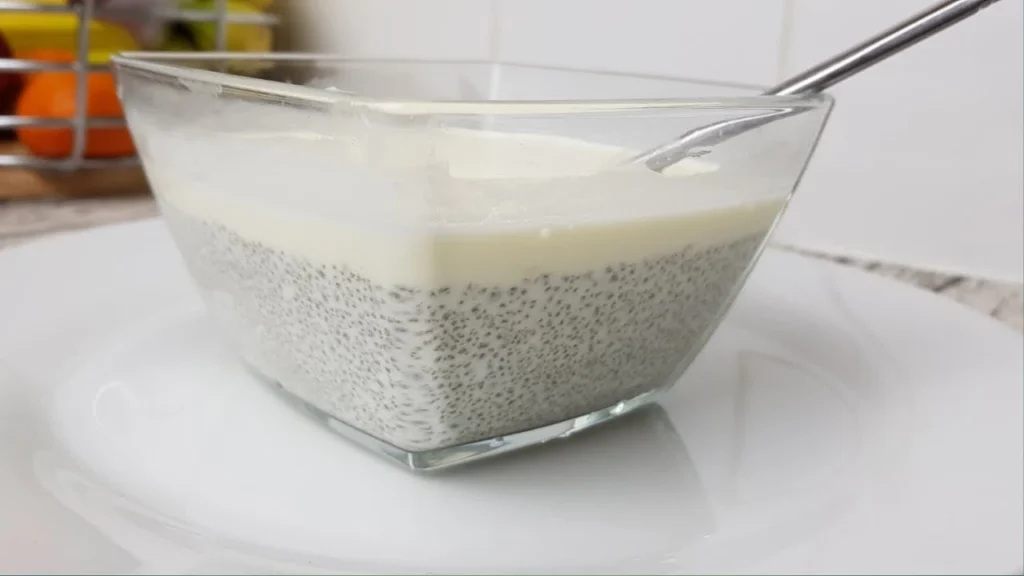
Sipping the Flavors of West Africa: Discovering Brukina
Hey there, beverage aficionados! Today, let’s embark on a flavorful journey to West Africa with a traditional and comforting drink – Brukina. Originating from Burkina Faso, this milky and spiced beverage has become a staple across the region, celebrated for its unique blend of ingredients and cultural significance.
Join me as we delve into the history of Brukina and craft this delightful drink that’s perfect for cozy evenings and gatherings.
Ghana Food – Brukina Ingredients:
- 1 cup millet or sorghum
- 4 cups water
- 2 cups whole milk
- 1/2 cup sugar (adjust to taste)
- 1 teaspoon ground ginger
- 1 teaspoon ground cinnamon
- 1/2 teaspoon vanilla extract
- A pinch of salt
- Ice cubes for serving (optional)
Ghana Food – Brukina Recipe:
1. Prepare Millet or Sorghum Base:
- Rinse the millet or sorghum under cold water. In a pot, combine the rinsed millet or sorghum with 4 cups of water. Bring to a boil, then reduce heat and simmer for 20-25 minutes until softened.
2. Strain and Cool:
- Strain the millet or sorghum, reserving the liquid. Allow the liquid to cool to room temperature.
3. Mix with Milk:
- In a large pitcher, combine the millet or sorghum liquid with whole milk.
4. Sweeten and Spice:
- Add sugar, ground ginger, ground cinnamon, vanilla extract, and a pinch of salt to the mixture. Stir well to combine.
5. Chill and Serve:
- Refrigerate the Brukina for at least 2 hours to allow the flavors to meld. Before serving, stir the drink and add ice cubes if desired.
6. Serve and Enjoy:
- Pour the chilled Brukina into glasses and serve it up for a refreshing and cultural experience.
Serving: This recipe makes approximately 4 servings.
Estimated Preparation Time: Approximately 30 minutes (excluding chilling time).
Nutritional Information:
- Calories per serving: 200 kcal
- Protein: 6g
- Carbohydrates: 32g
- Fat: 5g
- Fiber: 2g
Indulge in the unique taste of Brukina, a beverage that transcends borders and brings the warmth of West African hospitality to your table!
Ghanian Food – Grilled Tilapia

In Ghana, grilled tilapia is a popular dish and is often enjoyed alongside “banku” or “kenkey” (traditional fermented corn and cassava dough dishes) with hot pepper sauce. The Volta Lake in Ghana is a primary source of freshwater fish, including tilapia. The dish represents the essence of Ghanaian cuisine with its aromatic spices, fiery heat from peppers, and fresh ingredients.
History and Background
- Grilled fish, particularly tilapia, is a staple dish in many parts of Ghana.
- Fishing is an important industry along the Volta Lake and Ghana’s coastline, with tilapia being one of the predominant fish species caught.
- Grilled tilapia is often a star attraction at local food joints and eateries, especially in areas near the lake.
- The dish is traditionally served with a spicy pepper sauce, and often, as mentioned earlier, with “banku” or “kenkey.”
Ingredients for Ghanaian Grilled Tilapia
- 2 whole tilapia, gutted, scaled, and cleaned
- 2 tablespoons ginger paste
- 2 tablespoons garlic paste
- 1 large onion, finely chopped
- 2 Scotch bonnet peppers (adjust based on heat preference)
- 1 tablespoon ground anise
- 1 tablespoon ground cumin
- 1 tablespoon ground paprika
- 1/4 cup fresh lemon or lime juice
- Salt and pepper to taste
- 2 tablespoons vegetable oil
- Additional lemon or lime slices for garnish
Recipe for Ghanaian Grilled Tilapia
Preparing the Marinade
In a blender, combine the ginger paste, garlic paste, half of the chopped onion, Scotch bonnet peppers, anise, cumin, paprika, lemon/lime juice, salt, and pepper. Blend until a smooth paste forms.
Add the vegetable oil to the mixture and blend again to combine.
Marinating the Tilapia
- Make 2-3 deep diagonal slits on each side of the tilapia. This will help the fish absorb more flavor.
- Rub the prepared marinade all over the tilapia, ensuring it enters the slits and the cavity of the fish.
- Let the fish marinate for at least 1-2 hours in the refrigerator, allowing the flavors to penetrate.
Grilling the Tilapia
- Preheat your grill or charcoal barbecue to medium-high heat. Ensure the grates are clean and slightly oiled to prevent sticking.
- Once hot, place the marinated tilapia on the grill.
- Grill for about 10-15 minutes on each side, depending on the size of the fish, until it’s well-cooked, the skin is slightly charred, and the fish is flaky.
- Regularly baste the fish with any leftover marinade during the grilling process.
Serving
- Remove the grilled tilapia from the grill and place it on a serving plate.
- Garnish with lemon or lime slices.
- Serve hot with a side of banku or kenkey and a spicy Ghanaian pepper sauce.
The flavors of ginger, garlic, anise, and the heat from the Scotch bonnet peppers make this dish quintessentially Ghanaian. Grilled tilapia is celebrated not just for its taste, but also for the communal experience of enjoying it with family and friends.
Ghanian Cuisine – Fufu
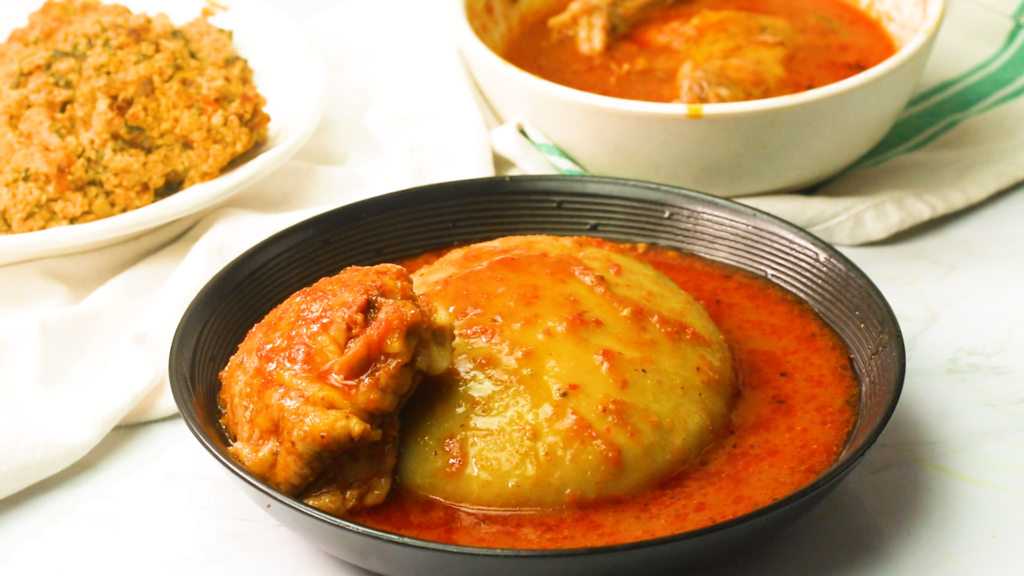
Fufu is a staple dish in many West African countries, including Ghana. It’s a starchy side dish made primarily from boiled and pounded starchy vegetables. In Ghana, fufu is typically made from a mixture of cassava and plantains or yams, though the exact ingredients can vary by region and personal preference.
History and Background
- Fufu is deeply rooted in West African culinary traditions and has been consumed for centuries.
- The preparation method of pounding the starchy ingredients to achieve the right texture is a communal activity in many places, often done with large mortars and pestles and requiring at least two people.
- Fufu is traditionally served with rich, flavorful soups and stews, making it a complete meal. Popular accompaniments include light soup, groundnut soup, and palm nut soup.
Ingredients for Ghanaian Fufu
- 2 ripe plantains
- 2 cassava roots (medium-sized)
- Water for boiling
- A pinch of salt (optional)
Recipe for Ghanaian Fufu
Preparing the Ingredients
- Peel the plantains and cassava. Make sure to remove the inner core of the cassava.
- Cut the plantains and cassava into chunks.
Boiling
- In a large pot, add the plantain and cassava chunks. Add enough water to cover them.
- Add a pinch of salt if desired.
- Bring the water to a boil and let the plantains and cassava cook until they are very soft, which usually takes about 30-40 minutes.
Pounding the Fufu
- Once the plantains and cassava are soft, drain the water and place them in a large mortar and pound them using a pestle. Traditionally, the mixture is pounded until stretchy and smooth. If you don’t have a mortar and pestle, you can use a stand mixer with a paddle attachment, but the traditional method is preferred for authentic texture.
- While pounding, it’s essential to turn and fold the mixture to ensure even consistency. This process requires effort and is traditionally done by two people, with one pounding and the other turning and folding.
Serving
Once the fufu is smooth and stretchy, shape it into balls and serve in a bowl.
Fufu is typically served with a side of soup or stew. When eating, take a bit of fufu, create an indentation with your fingers, scoop up some soup, and enjoy.
Fufu is a beloved dish in Ghana and is more than just food; it’s a cultural experience. The process of preparing it, especially the pounding, often brings people together, reinforcing communal ties. The dense, stretchy texture of fufu pairs perfectly with the rich, flavorful liquids of Ghanaian soups and stews.
Ghanian Cuisine – Banku
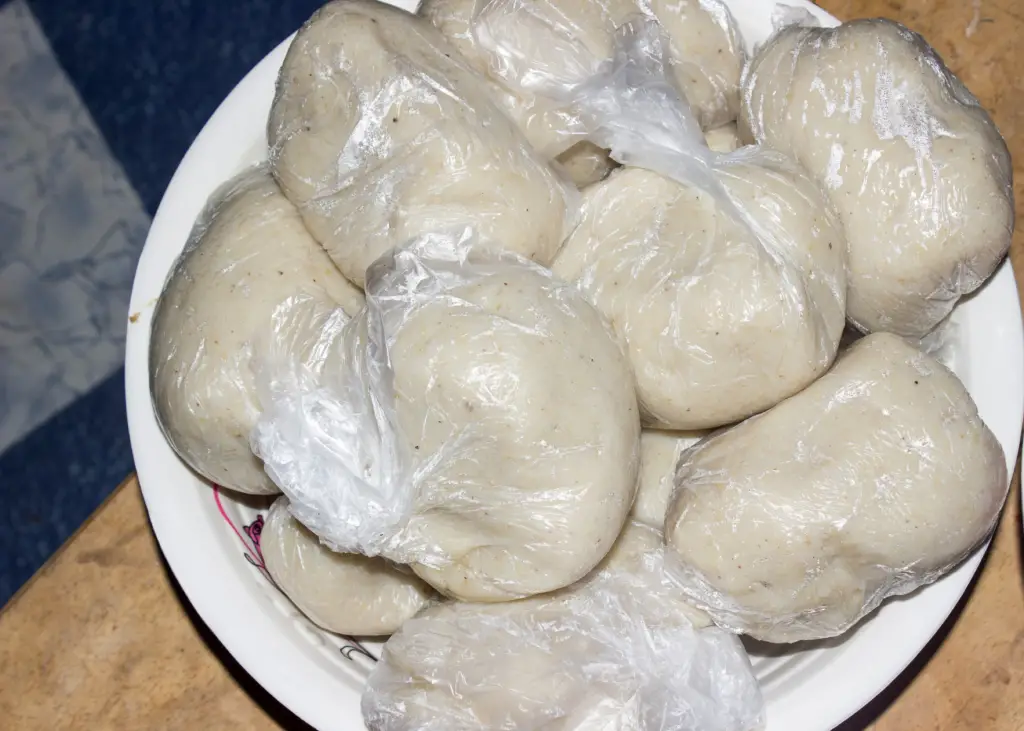
Banku is a traditional Ghanaian dish made from fermented corn and cassava dough. It is a staple food in many parts of Ghana and is similar in nature to dishes like kenkey, eba, and fufu. Banku is usually served with soups made from fish or meat, and a popular accompaniment is the hot pepper sauce with fish known as “tilapia soup.”
History and Background
- Banku, like other fermented dough dishes in West Africa, has deep cultural roots and is a symbol of communal culinary traditions in many Ghanaian communities.
- The fermentation process gives Banku its distinct sour taste and makes it easily digestible.
- Making Banku involves a blend of culinary skill and physical effort, particularly during the mixing stage to achieve its smooth, elastic texture.
- Traditionally, the fermentation process is a way to preserve grains and enhance their nutritional value.
Ingredients for Ghanaian Banku
- 2 cups fermented corn dough
- 1 cup fermented cassava dough
- 1-2 cups water (depending on desired consistency)
- A pinch of salt (optional)
Recipe for Ghanaian Banku
Prepare the Mixture
- In a large bowl, mix the fermented corn dough and fermented cassava dough together.
- Gradually add water and mix until you achieve a slightly thick consistency (like pancake batter). If it becomes too watery, you can add more fermented dough.
Cooking
- Pour the mixture into a large, sturdy pot and place it on medium heat.
- Stir continuously with a wooden spatula or banku “ta” (a traditional wooden tool for stirring banku). This continuous stirring is crucial to prevent lumps and achieve a smooth consistency. It also requires effort and can be quite the workout!
- As it cooks, the mixture will thicken. Keep stirring and turning the mixture for about 20-30 minutes.
- Once the Banku has become smooth, stretchy, and doesn’t stick to the sides of the pot, it’s done.
Serving
- Wet your hands with a bit of water to prevent sticking.
- Take a portion of the banku and shape it into a smooth ball or oval.
- Serve hot with your choice of soup or stew. Grilled tilapia with pepper sauce is a popular accompaniment to banku.
Banku’s slightly tangy taste, due to the fermentation process, makes it a unique and beloved dish in Ghana. The fermentation not only adds flavor but also increases the nutritional value by promoting the growth of beneficial bacteria. When combined with a rich, spicy soup or sauce, banku becomes a fulfilling and flavorful meal.
Ghanian Cuisine – Jollof Rice

Jollof rice is one of West Africa’s most celebrated dishes. Although the origins of Jollof rice are debated among countries like Ghana, Nigeria, Senegal, and Gambia, each region has its unique take on the dish. Ghanaian Jollof rice, specifically, has its own distinct characteristics.
History and Background
- Jollof rice is believed to have its origins in the Senegambia region of West Africa, influenced by the Wolof people, hence the name “Jollof” which is derived from “Wolof”.
- Over time, the dish spread across West Africa, with each country and even regions within countries adapting it to local tastes and ingredients.
- Ghanaian Jollof is known for its rich, savory flavor profile, often accompanied by proteins like chicken, beef, or fish.
- The playful rivalry between Ghana and Nigeria over who makes the best Jollof rice is well-known, often sparking light-hearted debates.
Ingredients for Ghanaian Jollof Rice
- 2 cups long-grain parboiled rice
- 1/4 cup vegetable oil
- 2 onions, finely chopped
- 2 cloves garlic, minced
- 1 tablespoon ginger, grated
- 2 ripe tomatoes, blended
- 2 tablespoons tomato paste
- 1 red bell pepper, blended
- 1 Scotch bonnet pepper (adjust based on heat preference), blended
- 2 cups chicken or vegetable broth
- 2 teaspoons thyme
- 2 bay leaves
- 1 teaspoon curry powder
- 1 cup mixed vegetables (e.g., carrots, peas, and green beans), optional
- 1 cup cooked meat or poultry (chicken, beef, or fish), optional
- Salt and pepper to taste
Recipe for Ghanaian Jollof Rice
Preparing the Base
- In a large pot or saucepan, heat the vegetable oil over medium heat. Add the chopped onions, and sauté until translucent.
- Add the minced garlic and grated ginger, and sauté for another minute.
- Stir in the tomato paste and cook for 2-3 minutes until it darkens slightly.
- Add the blended tomatoes, red bell pepper, and Scotch bonnet pepper to the pot. Cook for 10-15 minutes, stirring occasionally, until the mixture thickens and the oil begins to separate from the tomato mix.
Cooking the Rice
- Rinse the parboiled rice under cold water until the water runs clear. This helps to remove excess starch and prevents the rice from becoming too sticky.
- Add the rice to the tomato mixture in the pot, stirring well to coat each grain with the sauce.
- Pour in the chicken or vegetable broth and add the thyme, bay leaves, curry powder, salt, and pepper.
- Reduce the heat to low, cover the pot with a tight-fitting lid, and let the rice simmer for 20-25 minutes. Occasionally, give the rice a gentle stir to prevent it from sticking to the bottom of the pot.
Adding Vegetables and Meat
If using, add the mixed vegetables and cooked meat or poultry to the pot about 10 minutes before the rice is fully cooked. Mix gently to combine.
Serving
- Once the rice is cooked and has absorbed all the liquid, remove the bay leaves.
- Serve the Jollof rice hot, garnished with slices of fresh tomatoes, onions, or herbs of choice.
Ghanaian Jollof rice is often enjoyed during celebrations and gatherings. It’s not just a dish; it’s a reflection of Ghanaian culture, pride, and culinary artistry.
Ghanian Cuisine – Kenkey

Background
- Kenkey is deeply rooted in the Ghanaian culinary tradition. Like many West African fermented foods, it has been consumed for centuries and is an important part of the local diet.
- The fermentation process gives Kenkey its distinct sour taste and makes it easily digestible.
- Kenkey is typically served with fried fish, shito (pepper sauce), and sometimes, a side of soup.
- Due to its long shelf life, Kenkey has historically been ideal for travelers and for times when fresh food was scarce.
Ingredients for Ghanaian Kenkey
- 4 cups of dried maize (corn)
- Water for soaking and cooking
- Corn husks or banana leaves for wrapping (cleaned and softened in hot water)
Recipe for Ghanaian Kenkey
Preparing and Fermenting the Maize
- Soak the dried maize in water for about two days to soften.
- After soaking, drain the water and grind the maize into a smooth dough-like consistency. This can be done in a mill or using a mortar and pestle.
- Divide the dough into two portions. Set one portion aside – this will be the raw mixture.
- Slightly cook the other portion in a little water for about 10-15 minutes to form a thick paste. This will be the cooked mixture.
- Mix the cooked and uncooked portions together.
- Allow the combined dough to ferment for about 1-3 days, depending on your preferred level of fermentation. The longer it ferments, the sourer the Kenkey becomes.
Wrapping and Cooking the Kenkey
- After fermentation, divide the dough into desired serving sizes.
- Mold each portion into an oval or cylindrical shape.
- Wrap each portion in corn husks or banana leaves. Ensure the wrapping is tight to prevent water from entering.
- Place the wrapped kenkey into a large pot. Add enough water to cover them.
- Boil for about 1-2 hours. Ensure they are fully cooked by checking that they are firm to the touch.
Serving
- Remove the Kenkey from the pot and allow it to cool slightly.
- Unwrap the Kenkey and serve with accompaniments like fried fish, shito (pepper sauce), and soup or stew if desired.
Kenkey’s unique sour taste comes from the fermentation process, and its dense texture makes it a filling dish. The art of making Kenkey, especially the wrapping process, often requires skill, making it a cherished culinary tradition in many Ghanaian households.
Ghanian Cuisine – Red Red
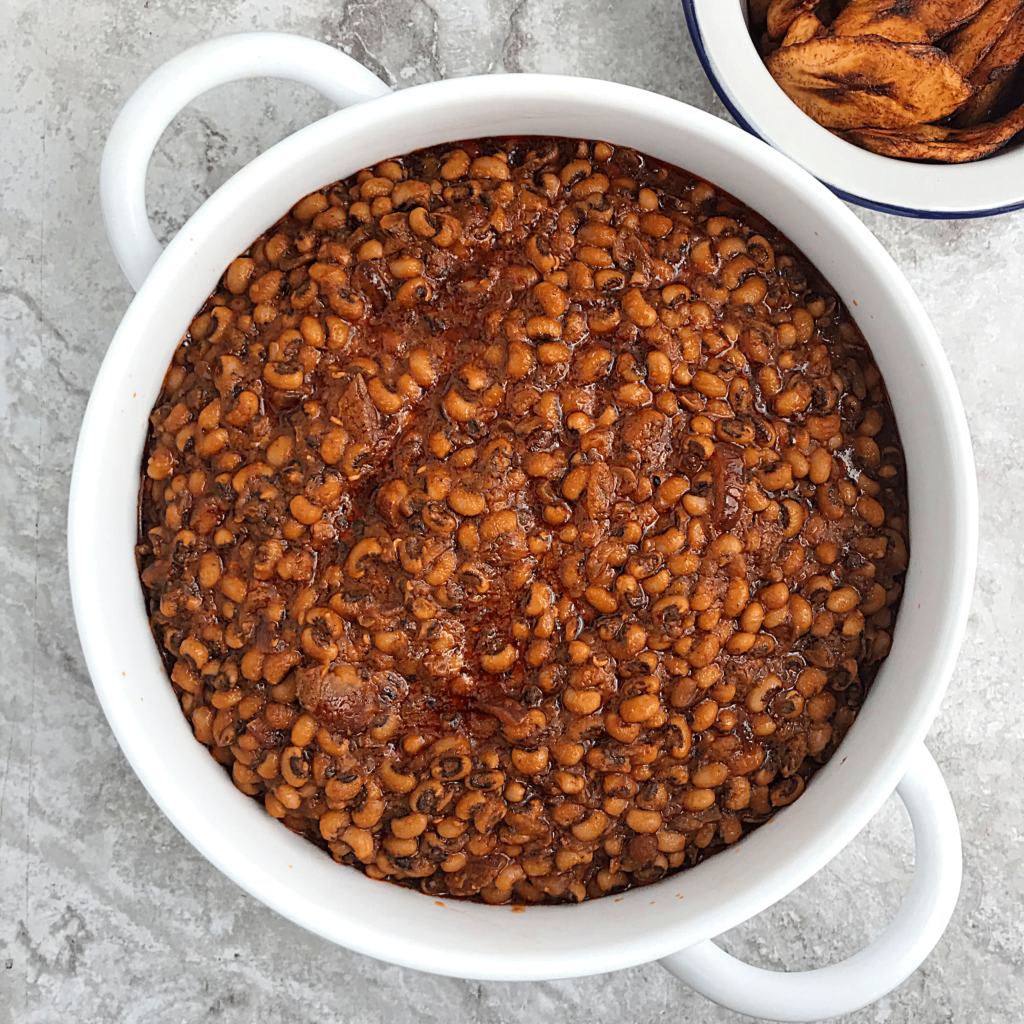
“Red Red” is a popular Ghanaian bean stew that gets its name from the use of red palm oil and red kidney beans or cowpeas. This hearty stew is often served with fried plantains, making it a beloved dish, especially in southern Ghana.
History and Background
- Red Red is a staple for many in Ghana, largely because of its rich flavor profile combined with the nourishing benefits of beans.
- The use of red palm oil, a traditional ingredient in West African cooking, imparts a distinctive taste and color to the dish.
- The dish has its roots in Ghanaian traditions and is often seen as comfort food, enjoyed by both locals and visitors alike.
Ingredients for Ghanaian Red Red (Bean Stew)
- 2 cups of dried red kidney beans or cowpeas
- 4 cups of water (for boiling)
- 1 cup of red palm oil
- 1 large onion, finely chopped
- 2 cloves of garlic, minced
- 1 tablespoon of grated ginger
- 2 ripe tomatoes, blended
- 2 tablespoons of tomato paste
- 1 Scotch bonnet pepper (adjust based on heat preference), finely chopped or blended
- 1 teaspoon of thyme
- 1 smoked fish (like mackerel or herring), cleaned and flaked (optional)
- 2 cups of fish or vegetable broth
- Salt and pepper to taste
Recipe for Ghanaian Red Red (Bean Stew)
Preparing the Beans
- Rinse the beans and soak them overnight to soften.
- The next day, drain the beans and place them in a pot with 4 cups of water. Bring to a boil and then reduce the heat to let them simmer until they are tender. This should take about an hour.
- Once cooked, drain the beans and set them aside.
Preparing the Stew
- In a large pot, heat the red palm oil over medium heat. Add the chopped onions and sauté until they become translucent.
- Add the minced garlic and grated ginger, sautéing for an additional 2 minutes.
- Stir in the tomato paste and cook for about 2-3 minutes.
- Add the blended tomatoes and Scotch bonnet pepper to the pot. Cook this mixture until the tomatoes lose their acidity and the oil begins to separate from the tomato sauce, about 10-15 minutes.
- If you’re using smoked fish, add it now, breaking it into pieces.
- Add the cooked beans to the pot, mixing well.
- Pour in the fish or vegetable broth, ensuring the beans are well submerged. If you need more liquid, you can add some water.
- Add thyme, salt, and pepper. Stir well.
- Reduce the heat, cover the pot, and let it simmer for about 30 minutes.
Serving
Red Red is traditionally served with fried ripe plantains. To prepare these, peel and slice ripe plantains and fry them in oil until they are golden brown.
Serve the bean stew hot alongside the fried plantains.
Red Red is a flavorful and nourishing dish, enjoyed by many Ghanaians. The combination of spicy bean stew and sweet fried plantains creates a satisfying contrast in flavors and textures.
Ghanian Cuisine – Kelewele
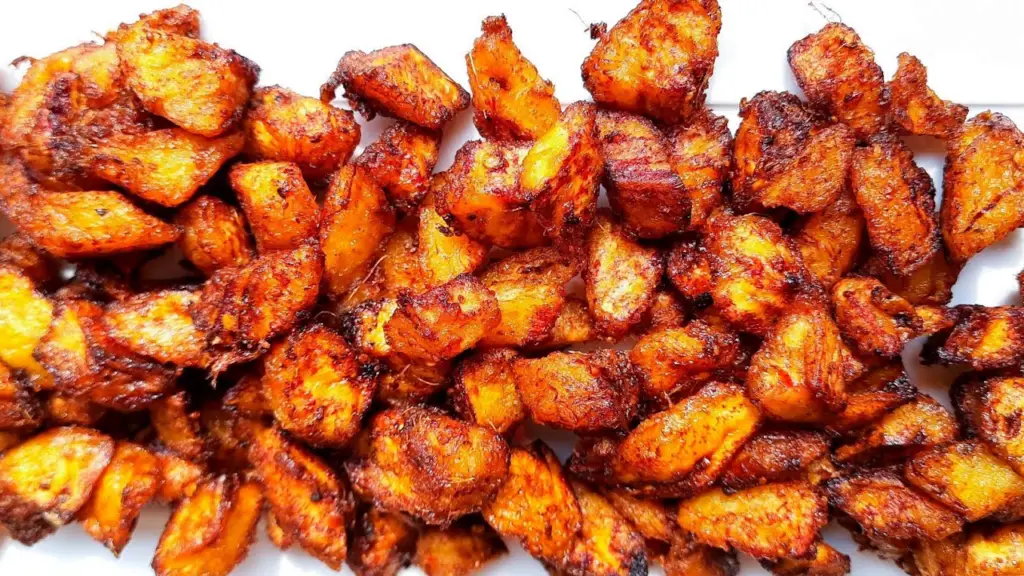
Kelewele is a much-loved Ghanaian snack made from ripe plantains that are seasoned with spices and then fried until they’re golden and crispy. This delicious treat is popular as a street food item and is often enjoyed in the evenings.
History and Background
- Kelewele is a traditional Ghanaian snack often sold by street vendors, especially in the evenings.
- The blend of sweet ripe plantains with spicy seasonings creates a delightful flavor profile that’s both sweet and spicy.
- It is believed that the combination of spices, particularly the hot pepper, aids digestion and provides a warm, comforting feeling, which makes the snack especially popular in the cooler evenings.
- Kelewele is also commonly served at parties and gatherings as a tasty finger food.
Ingredients for Ghanaian Kelewele
- 4 ripe plantains
- 1 teaspoon of ground cayenne pepper (adjust to your heat preference)
- 1 teaspoon of ground ginger
- 1/2 teaspoon of ground cloves
- 1/2 teaspoon of ground nutmeg
- 1 teaspoon of salt (or to taste)
- 1 small onion, grated or finely chopped (optional for added flavor)
- 2 cloves garlic, minced (optional)
- Vegetable oil for frying
Recipe for Ghanaian Kelewele
Preparing the Plantains
Begin by peeling the ripe plantains. To do this, make a shallow cut lengthwise along the ridges of the plantain and peel away the skin.
Once peeled, cut the plantains into bite-sized cubes or diagonally into chunky slices.
Seasoning the Plantains
In a large mixing bowl, combine the ground cayenne pepper, ground ginger, ground cloves, ground nutmeg, salt, grated onion, and minced garlic (if using). Mix well.
Add the plantain pieces to the bowl and toss them thoroughly in the spice mixture, ensuring each piece is well coated.
Frying the Plantains
- In a frying pan or deep fryer, heat the vegetable oil over medium heat. The oil should be deep enough to cover the plantain pieces.
- Once the oil is hot, carefully add the seasoned plantain pieces, ensuring not to overcrowd the pan.
- Fry the plantains for about 3-4 minutes on each side, or until they are golden brown and crispy.
- Once fried, remove the plantain pieces and place them on paper towels to absorb any excess oil.
Serving
Kelewele is best enjoyed hot. You can serve it as is, or with a side of roasted peanuts for added texture and flavor.
Kelewele’s spicy and sweet combination has made it a favorite among many, both in Ghana and beyond. Whether as a street food treat or as a side dish at family gatherings, its delicious taste is hard to resist.
Ghanian Cuisine – Bofrot
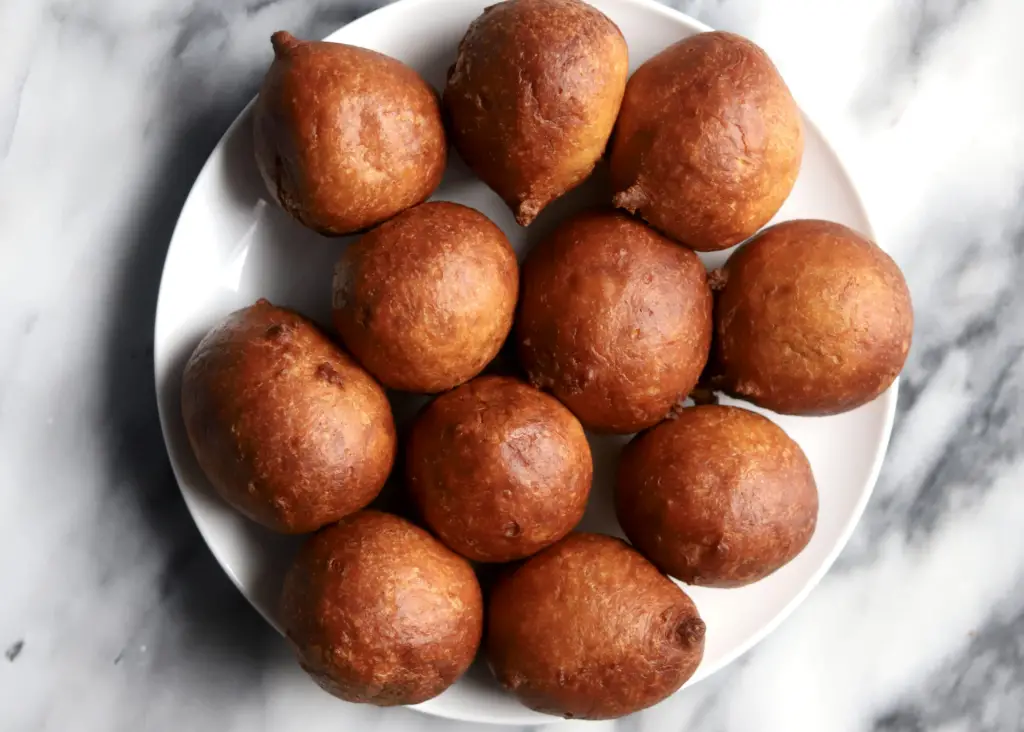
Bofrot, sometimes referred to as “puff-puff” in some West African countries, is a popular deep-fried doughnut-like snack in Ghana. It’s fluffy, slightly chewy, and often sweet.
History and Background
- Bofrot is enjoyed by many in Ghana, especially as a breakfast item or an evening snack.
- The snack has a deep-rooted history in Ghanaian street food culture. It’s commonly sold by street vendors who fry it fresh, often accompanying it with porridge or other local beverages.
- While variations of fried dough exist worldwide, Bofrot is special due to its specific texture, flavor, and the cultural significance it holds in Ghana.
Ingredients for Ghanaian Bofrot
- 2 cups of all-purpose flour
- 1/2 cup of sugar (can adjust based on desired sweetness)
- 1/2 teaspoon of salt
- 1 tablespoon of active dry yeast
- 1 cup of warm water (you may not need the entire cup, so add gradually)
- 1 teaspoon of nutmeg (optional, but adds flavor)
- 1 egg (optional, some recipes include it for a richer taste)
- Vegetable oil for frying
Recipe for Ghanaian Bofrot
Preparing the Dough
- Start by activating the yeast. In a small bowl, mix the active dry yeast with about a 1/4 cup of the warm water and a teaspoon of sugar. Set it aside for about 5-10 minutes until it becomes frothy.
- In a separate large mixing bowl, combine the all-purpose flour, sugar, salt, and nutmeg (if using).
- Once the yeast mixture is frothy, add it to the dry ingredients.
- If you’re using an egg, whisk it and add it to the mixture now.
- Gradually add the remaining warm water while mixing, until you get a smooth and slightly sticky dough. You might not need the entire cup of water, so add it gradually to ensure the dough doesn’t become too watery.
- Cover the bowl with a clean cloth and set it in a warm place to rise for about 1-2 hours, or until it has doubled in size.
Frying the Bofrot
- Once the dough has risen, heat the vegetable oil in a deep frying pan or pot over medium heat. The oil should be deep enough to allow the bofrot balls to float.
- Wet your hands a bit to prevent the dough from sticking to them. Pinch off a piece of the dough and, using your fingers, drop it into the hot oil. The dough should sizzle and rise to the surface.
- Fry the bofrot balls, turning them occasionally, until they are golden brown all over. This should take about 3-5 minutes per ball.
- Remove the fried bofrot from the oil and place them on paper towels to absorb excess oil.
Serving
Bofrot is best enjoyed warm. Serve them as they are or with a beverage like cocoa, tea, or coffee.
These golden balls of deliciousness are a delight to eat and a favorite for many who have tasted them. The outside is slightly crispy, while the inside remains soft and fluffy. Enjoy your homemade Ghanaian Bofrot!
Ghanian Cuisine – Waakye

Waakye (pronounced ‘waa-chay’) is a renowned Ghanaian dish made primarily from rice and beans, typically black-eyed peas or cowpeas. The unique aspect of Waakye is its distinctive reddish-brown color, achieved by using dried millet leaves or sorghum leaves during the cooking process.
History and Background
- Waakye is a staple food for many Ghanaians and is commonly eaten for breakfast or lunch.
- The name “Waakye” is derived from the Hausa word “Wakai”, which means “beans”.
- Traditionally, Waakye is sold by street vendors wrapped in banana leaves, which impart a distinct flavor to the dish.
- The dish has transcended ethnic boundaries in Ghana, becoming popular among various groups, and can now even be found in some restaurants outside of Ghana.
Ingredients for Ghanaian Waakye
- 2 cups of rice (long-grain is preferred)
- 1 cup of black-eyed peas or cowpeas
- 4-5 dried millet leaves or sorghum leaves (known locally as Waakye leaves). If unavailable, you can use baking soda as a substitute to achieve the reddish-brown color.
- 1 teaspoon of salt (or to taste)
- 4 cups of water (may need more depending on rice type and desired texture)
- Optional: Meats, fish, or shrimp to be cooked and served with the Waakye.
Recipe for Ghanaian Waakye
Preparing the Beans
Soak the black-eyed peas or cowpeas in water for several hours or overnight to soften them.
After soaking, rinse the beans, place them in a pot, cover them with water, and bring to a boil. Reduce the heat and let them simmer until they are half-cooked.
Preparing the Waakye Leaves
If using dried millet or sorghum leaves, wash them thoroughly to remove any dirt. Place them in a pot with some water and bring to a boil. The water will begin to turn reddish-brown. This is your coloring agent for the Waakye.
Cooking the Waakye
- Once the beans are half-cooked, add the rice to the pot.
- Strain the reddish-brown water from the boiled leaves into the pot containing the rice and beans. If you’re using baking soda instead of leaves, add about 1/2 teaspoon to the pot to get the desired color.
- Add salt and more water if necessary to cook the rice and beans to your desired texture.
- Stir occasionally and let it cook until the rice is done and the beans are tender.
Serving
- Waakye is typically served with a variety of accompaniments such as fried fish, boiled eggs, stewed meats, shrimp, ‘shito’ (pepper sauce), avocado, fried plantains, or spaghetti.
- ‘Gari’ (grated cassava granules) and a vegetable salad can also be added on the side.
Waakye is not just a meal; it’s an experience. The unique flavor and color, combined with the variety of accompaniments, make it a feast for both the eyes and the palate. Whether you have it for breakfast, lunch, or dinner, Waakye is undeniably a taste of Ghanaian culinary heritage.
Ghanian Cuisine – Kooko
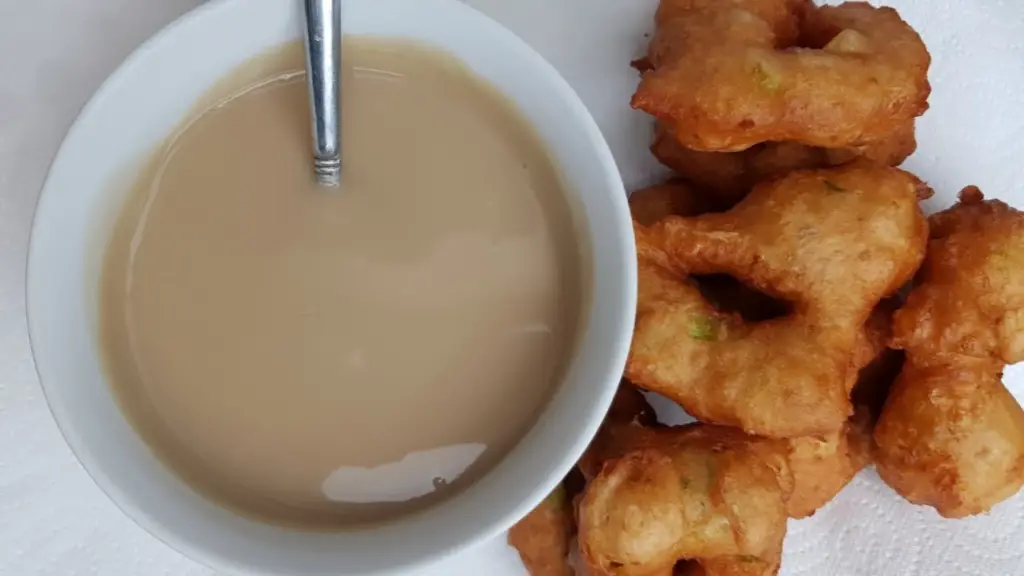
“Kooko” (also spelled “koko” or “kookoo”) is a popular breakfast dish in Ghana. It is a slightly sour and spicy porridge made from fermented corn dough and often served with bread or ‘bofrot’ (fried dough balls).
History and Background
- Kooko has its roots in the Ga ethnic group but has become a staple breakfast dish across Ghana.
- It’s commonly sold by street vendors in the early morning hours. You’ll often find people buying it on their way to work or school.
- The fermentation process gives Kooko its characteristic sour taste, which is contrasted by the spicy accompaniments.
Ingredients for Ghanaian Kooko
- 1 cup of fermented corn dough (available at African grocery stores or can be homemade by fermenting corn flour in water for a few days)
- 4 cups of water
- 1 teaspoon of ground red pepper (or to taste)
- 1 teaspoon of ground ginger
- 1/2 teaspoon of cloves
- Salt to taste
- Optional: Sugar or sweetener if you want a sweeter taste
- Optional: Groundnut paste or peanuts for added flavor
Recipe for Ghanaian Kooko
Preparing the Kooko
- In a bowl, mix the fermented corn dough with 2 cups of water. Stir thoroughly until you have a smooth mixture.
- Strain the mixture through a sieve into another bowl to separate the chaff from the liquid. You should be left with a smooth, lump-free liquid.
- Pour the liquid into a pot and place it on medium heat. Add the remaining 2 cups of water.
- Stir continuously to prevent lumps from forming.
- As the mixture heats, it will start to thicken. Keep stirring until you have a smooth, thick consistency similar to custard.
- Add the ground red pepper, ground ginger, cloves, and salt. Stir well.
- If using groundnut paste or peanuts, add it now and stir until well mixed.
- Allow the mixture to simmer on low heat for about 10 minutes, stirring occasionally.
Serving
- Pour the hot Kooko into bowls.
- Some people like to add sugar or a sweetener at this point, while others prefer it without. Adjust to your preference.
- Kooko is commonly served with bread, but it’s especially delightful with ‘bofrot’ or other fried dough pastries.
- Some vendors also serve it with groundnuts or ‘chichinga’ (kebab) on the side.
Kooko’s unique taste, derived from the fermentation process, combined with its spicy undertones, makes it a favorite breakfast for many Ghanaians. It’s hearty, filling, and provides a good energy boost to start the day.
Conclusion
I hope this culinary journey to Ghana has inspired you to explore the diverse and flavorful world of Ghanian cuisine. From the essence of Ghanian cooking to staple foods, meats, and seafood, vegetarian options, street foods, desserts, and beverages, there’s something for everyone to taste in Ghanian food culture.
Ghanian cuisine is a celebration of diversity, reflecting the country’s history and cultural heritage. It’s exciting to learn about the different regional variations and unique dishes that showcase the best of Ghanian flavors and aromas. If you’re ready to try your hand at cooking Ghanian recipes, be sure to use traditional Ghanian spices and cooking techniques to capture the authentic flavors of Ghana in your kitchen.
With a wide range of dishes and ingredients, Ghanian cuisine is a must-try for food lovers around the world. Don’t hesitate to explore this rich culinary heritage and indulge in the unforgettable tastes of Ghana!
FAQ’s
What is Ghanian cuisine?
Ghanian cuisine refers to the traditional food and cooking techniques of Ghana, a country in West Africa. It is known for its bold flavors, diverse ingredients, and rich cultural influences.
What are some popular Ghanian dishes?
Some popular Ghanian dishes include jollof rice, banku with okro soup, waakye, kelewele, and fufu with light soup. These dishes showcase the unique flavors and ingredients of Ghanian cuisine.
Are Ghanian dishes spicy?
Yes, Ghanian dishes are known for their spicy flavors. Many dishes feature the use of spices like ginger, garlic, chili peppers, and aromatic seasonings.
Are there vegetarian options in Ghanian cuisine?
Absolutely! Ghanian cuisine offers a variety of vegetarian options such as red-red, a bean stew, and palava sauce made with leafy greens. These dishes are packed with flavor and perfect for vegetarian food enthusiasts.
What are some traditional Ghanian desserts?
Traditional Ghanian desserts include palm nut soup, coconut milk ice cream, and mango with sticky rice. These desserts are a delightful way to end a Ghanian meal.
Can I recreate Ghanian dishes at home?
Yes, you can! With the right ingredients and recipes, you can recreate the flavors of Ghanian cuisine in your own kitchen. Explore traditional Ghanian recipes and cooking techniques to bring the taste of Ghana into your home.
What are some staple foods in Ghanian cuisine?
Staple foods in Ghanian cuisine include fufu, banku, jollof rice, and kenkey. These dishes are often served with various soups, stews, or sauces.
What are some popular Ghanian street foods?
Ghanian street foods are a must-try! Some popular options include kelewele (spicy fried plantains), bofrot (fried doughnuts), waakye (rice and beans), and kooko (spiced millet porridge).
Are there any traditional Ghanian beverages?
Yes, Ghanian cuisine offers a variety of traditional beverages such as bissap (hibiscus tea), palm wine, and ginger beer. These drinks are refreshing and complement the flavors of Ghanian dishes.
What spices are commonly used in Ghanian cuisine?
Commonly used spices in Ghanian cuisine include scotch bonnet pepper, grains of paradise, ginger, garlic, and cloves. These spices add depth and complexity to Ghanian dishes.
How does Ghanian cuisine celebrate diversity?
Ghanian cuisine is influenced by various ethnic groups and cultural traditions within the country. Each region of Ghana has its own unique dishes that reflect the diversity of the nation.
How can I explore Ghanian cuisine further?
To further explore Ghanian cuisine, you can try visiting Ghanian restaurants, attending food festivals, or connecting with Ghanian communities. You can also find numerous cookbooks and online resources that offer Ghanian recipes and cooking tips.
Date Last edited

